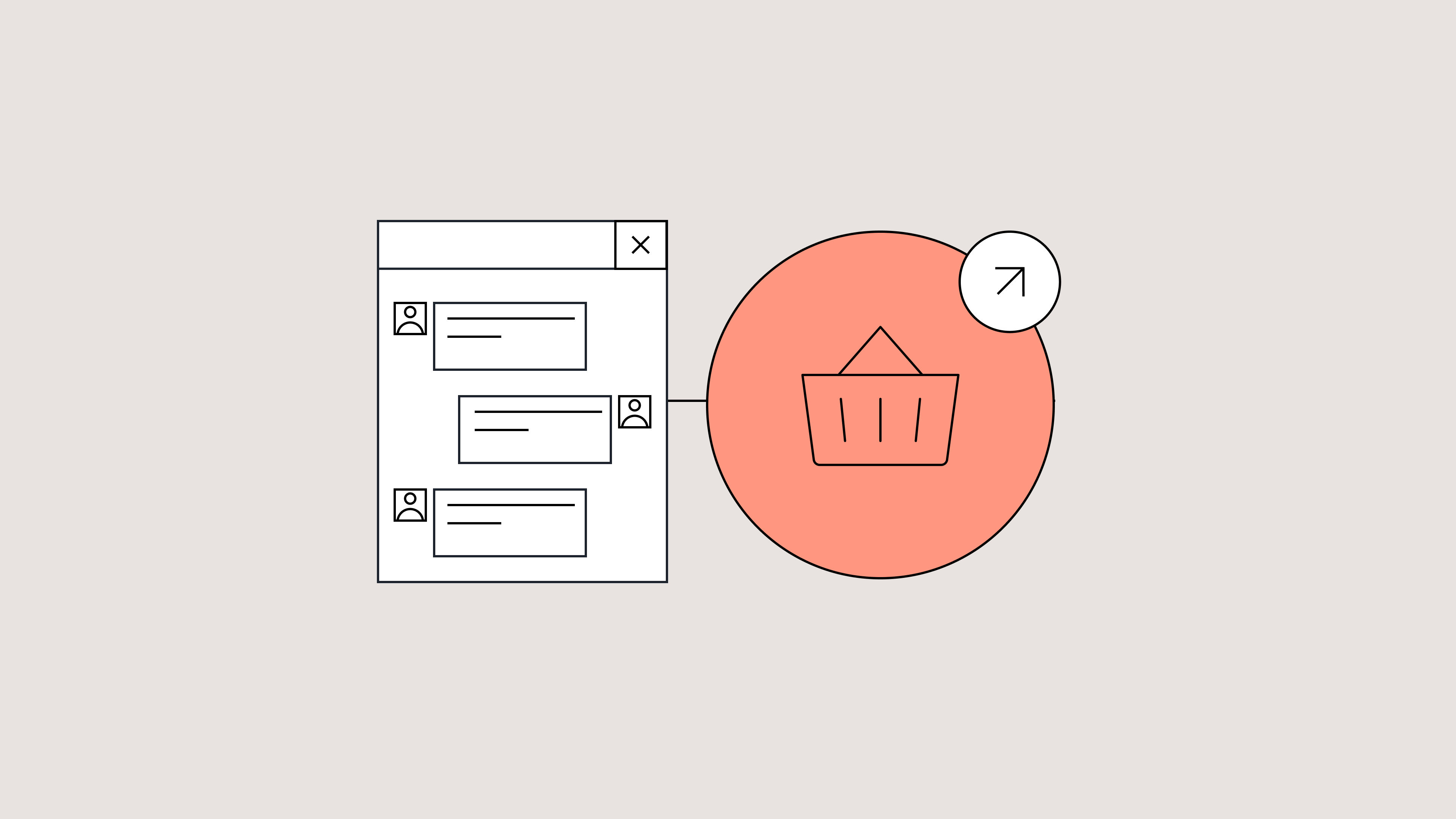


What Happens When CX Agents Love Their Platform? Ask Glossier, Tommy John, and Brunt Workwear
TL;DR:
- Happy agents lead to better CX outcomes. When agents genuinely enjoy using their platform, it boosts productivity, morale, and customer satisfaction.
- Gorgias makes agents’ lives easier. CX teams at Glossier, Tommy John, and Brunt Workwear unanimously preferred Gorgias over legacy systems.
- AI helps teams scale without losing the human touch. By handling basic inquiries, AI gives agents more time for high-impact conversations and personalized support
- Agent satisfaction drives business impact. Brands saw improved team efficiency, reduced operational friction, and revenue gains from more focused, empowered agents.
Everyone talks about how important it is for your ecommerce tools to drive business growth, boost productivity, and deliver a high return on investment. But the equally important (yet often overlooked) third layer is how a tool affects the people using it day-to-day.
The hidden costs of sticking to the CX status quo
The moment CX and ecommerce leaders start noticing slipping KPIs, frustrated agents, or rising support costs, they ask themselves a question, “Is it time to look for something new?” Sticking with the same tool might seem easier — no demos, evaluations, migrations, onboarding, or retraining involved.
But ignoring the shortcomings of your current CX platform can snowball into larger issues over time.
When CX agents don’t like the platform they’re working in daily, bigger problems arise:
- Agent productivity declines
- Morale and employee retention suffer
- Operational costs rise
- Customer experience takes a hit
- Poor data and reporting if agents aren’t using tags or ticket fields correctly
Beyond the thousands of dollars saved in operational costs or hours saved per ticket, Gorgias helps CX agents focus on what they do best — creating the best customer experience possible.
When a platform makes agents’ lives easier, they have more time to focus on the moments that matter, like proactively reaching out to VIPs, sending surprise birthday gifts, or empathetically handling nuanced tickets. Not to mention, they enjoy doing it.
At our annual customer conference, Gorgias Connect, we asked three CX leaders to share their experiences using Gorgias. Aside from the impressive FRTs and CX-generated revenue metrics, one theme stood out — they all mentioned how much their agents enjoyed using Gorgias.
Glossier’s agents have more time to be expert product consultants
Emily Weiss first launched a beauty blog and community, Into the Gloss, in 2010 as a space dedicated to sharing real information, advice, and tips with real people.
This laid the groundwork for Glossier, launching in 2014 with a fresh “skin first, makeup second” philosophy. Amidst the “full glam” era of makeup defined by smoky eyes and bold lips, Glossier’s skincare-oriented approach disrupted the norm.
From the beginning, Glossier has attracted a strong community thanks to its products designed based on community feedback and its social media presence. Today, more than a decade later, the brand has evolved, but its core principles have stayed the same.
As a customer-obsessed beauty brand, it’s no surprise that Glossier takes a thoughtful approach to customer experience.
We sat down with Cati Brunell-Brutman, Head of CX at Glossier, to dive into how the team uses Gorgias to make their lives easier while creating better relationships with customers.
Glossier’s proactive approach to customer experience
How do you approach customer experience at Glossier?
I always like saying customer experience vs. customer service because I think customer service feels like we’re just solving problems in a transactional way. Customer experience is proactive and involves looking at the entire customer journey.
Our team interacts with customers from the moment they first land on the website to when they become repeat users of a product, and eventually, when they become subscribers. There are many opportunities along the way for our team to connect with people, engage in conversations, and make complementary product recommendations.
This was what our founder really wanted this team to be—beauty editors. Everyone on the CX team is an editor (or a product expert), making curated recommendations. My vision for our CX team is to give them more time to lean into that.
Simplifying workflows with AI to empower agents
What are you doing differently now to make sure that your team and your business are more resilient?
My motto for the year is simplify and automate. I don't want anyone on my team to spend their whole day in a Google spreadsheet. So I’m asking questions like, ‘What can I automate? How can I connect tools?’
I really look to my team, especially the newer members, for this, and encourage them to ask, 'Why do we do this?' Because if the answer is because we've always done it that way, that's not a good enough answer for me.
I’m focusing on finding those moments to simplify things so that the team can concentrate on impactful work, such as creating connections and engaging with people. That’s what I really want my team to focus on because it’s what brings value to their work, our customers, and the brand.
How did your team react when you switched to Gorgias from your previous platform?
We actually had our agents weigh in on this. We showed them demos of all the platforms we were considering and had them attend the meetings to speak with the teams.
Then, we ran a poll in Slack and asked the team, ‘If you were making this decision, what platform would you choose?’ All of the agents unanimously voted for Gorgias. So, we’re definitely fans.
How has implementing AI into your CX strategy affected the team?
Throughout the industry, I think people are concerned that there’s going to be a transition to a state where CX is 100% AI, everybody is going to lose their jobs, and customers won’t be able to talk to a person.
But as we've implemented AI at Glossier, we’ve maintained the same team size as when we first started. We just have so much more automation of things like with WISMO tickets, returns, exchanges, and basic tickets that we don’t need a human to answer with macros for six hours straight.
Deeper human-to-human connections powered by better tools
With the additional capacity, what can your team now focus on?
The team is actually able to do more work because they're not dealing with an antiquated technical system, which makes their jobs easier and also saves us money in the long run.
Now, our agents can perform tasks that actually require a human. AI can send out tracking links, and people can do the people work.
We receive a lot of questions about our products, like how to use them or specific recommendations. And that's when we want a person to sit down, look at the customer’s selfie, and do a shade match. Then our editors can ask follow-up questions about what the shopper is looking for and why.
What makes your agents unique, and how does Gorgias help support them?
One of the things that I really love about Glossier is that our editors — our agents — are people, and we have customers who know them by name.
It’s really unique, and they’re almost like internet celebrities within our community. I'll go to our Reddit page and see customers posting screenshots of their conversations with our agents, and other customers will reply saying ‘Oh my gosh, yes!’ or ‘They helped me too!’
Customers will DM us things like ‘This editor recommended a lipstick for me. It was great, I love it. Can that person recommend a blush for me as well?’
Being able to aggregate all those conversations across social media DMs, emails, and chats in one place is invaluable.
Where would your team be without Gorgias?
Having a really bad time in Gmail.
Tommy John found that Gorgias was the perfect fit for its CX team
In 2008, Tom Patterson was a medical salesperson frustrated with ill-fitting undershirts. This problem he faced every day was the catalyst for him to found Tommy John, a dual-gender underwear, loungewear, and apparel company.
Tommy John launched with its flagship product, the Stay-Tucked Undershirt, to solve Tom’s initial struggle that he knew other customers were also facing. Fast-forward a few years, and Tommy John expanded into more categories with innovative underwear product lines
Customer comfort has always been the main priority for Tommy John, embedded in everything from product design to its Best Pair Guarantee. The CX team is responsible for maintaining a customer experience that is just as smooth and seamless as the products they're buying.
Max Wallace, CX Director at Tommy John, shared his experience migrating from a legacy platform to Gorgias and how it impacted his team.
The search for a platform that supported both customers and agents
What motivated you to find a new platform?
We knew we had to seriously explore other options when we were assigned yet another Customer Success Manager on our former platform after having gone through several in a short span. It felt like we were starting from scratch every time, which made it challenging to elevate our CX alongside such a critical partner.
We wanted to do right by our customers and our agents, ensuring they had the reporting and tools they needed, plus more. Gorgias really offered all of those things.
What was most important to you and your team when evaluating helpdesks?
We didn’t want anything that was reinventing the wheel. One platform we looked at wasn’t doing the agents justice by only allowing them to view their own tickets.
We really wanted our agents to have a holistic understanding of the volume we’re receiving, which Gorgias provides. Now they have this fleshed-out understanding of every customer interaction, and that’s been a game-changer. They’ve been loving it.
Gorgias gave agents the tools they needed to thrive
How has Gorgias impacted agent productivity and impact?
We have definitely seen greater speed and productivity. Even something as simple as macro suggestions has helped steer new agents in the right direction. That’s going to be huge during peak seasons, like BFCM.
And the fact that agents can move seamlessly between conversations without losing context means they’re handling more interactions, faster, with less frustration. They feel confident in their workflows, rather than being bogged down in repetitive tasks.
Within two months, using Gorgias’s AI Agent has enabled agents to minimize time-consuming manual tasks and spend more time with high-intent customers, generating over $100,000 in sales.
I’m confident Gorgias will help us achieve our goal of making selling and CX much more integrated. We do want to reward our team for their efforts in driving sales, and we can track conversion rates per agent in Gorgias.
Why was voice integration such a priority for your team?
Before, our agents didn’t have visibility into previous phone calls that other agents had taken. I can't tell you how many times there has been confusion regarding what's going on with the customer because our agents did not have visibility into the customer’s history. We’d have to pull the call recording, pass it along, and by then, the customer would have already been waiting.
So it was essential for us to find a helpdesk that we could use voice with. Now with Gorgias Voice, agents can look back in the timeline, listen to the call, or even read a transcript or AI-generated summary. That’s just been amazing, and they’re loving that.
Tying revenue back to call tickets, where most of our upselling and cross-selling happens, has been another huge win.
Tommy John’s agents unanimously prefer Gorgias
How did agents react after the switch?
The number one thing that validates that we made the right decision is that our agents truly love Gorgias.
Two weeks after going live, we asked, ‘Do you feel you will be more efficient working in Gorgias than our previous platform?’ And it was unanimous — Gorgias, completely. And this was just two weeks in, with everyone still getting their feet wet.
We sent out a survey, and seeing every single person answer in favor of Gorgias told me everything I needed to know about how quickly the team was adapting and how much they preferred the platform.
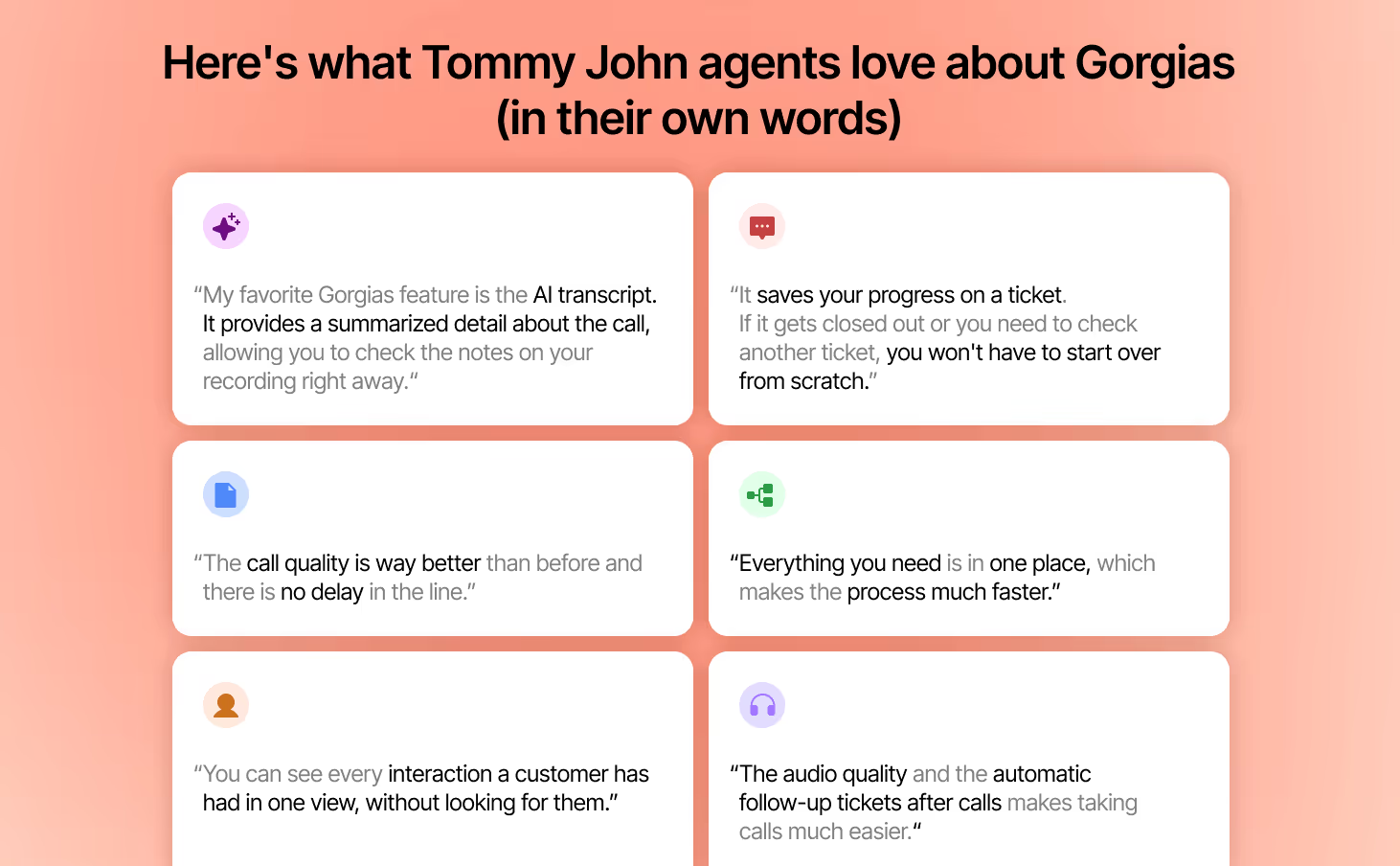
What has been the CX team’s feedback after using Gorgias for a while?
Gorgias has really paid off for our agents in terms of their efficiency. Being able to transition seamlessly from a phone call to a follow-up email with just one click is amazing. And having all of that in the timeline — phone calls, emails, chats — that can’t be beat.
Brunt Workwear’s team stays engaged by helping more customers each day
Eric Girouard founded Brunt Workwear in 2019 to fill a gap in the market for comfortable, high-quality workwear for skilled tradespeople. He came from blue-collar roots himself, and many of his friends and family also work in the trades.
Eric started the company in his garage, focusing on direct-to-consumer sales. Brunt Workwear aims to create products that aren’t just for tradespeople, but are actually built by them.
The workwear brand incorporates a significant amount of customer feedback into the design process to create products that actually make their lives easier. Brunt Workwear’s commitment to its customers is even more evident in its product naming convention — each product is named after a specific tradesworker.
When we spoke with Ruth Trieger, Director of Customer Experience, she shared how the CX team achieves its goal of making solutions as easy as possible for their busy customers — and why agent satisfaction can’t be overlooked.
How Brunt Workwear makes every customer feel at home
How do you think about the state of CX today?
The best retail or CX advice I’ve ever received is to think of everyone who walks into your store or visits your website as someone entering your home. For every visitor, you will do some basic things, such as taking their coat or offering them something to eat or drink. But if you truly want to make someone feel welcome, you’re going to meet them in a way that aligns with their preferences and makes them feel like they’re a part of something.
When you make someone feel welcome, they build an emotional connection with a brand that far transcends any product. That’s a powerful thing.
As I consider customer experience and the growth of AI, I realize there is a constant need to deliver fantastic experiences while using the right amount of resources. If you can do that while still creating a memorable experience, you have a customer for life.
Making life easier for customers and agents with an intuitive platform
What is your goal when designing experiences for Brunt Workwear’s customers?
Our customer is very busy and very hardworking. They have very little spare time. So if or when something goes wrong, I encourage my team to think, ‘How can we make the solution as easy as possible?’ That’s our goal — to put ourselves in their shoes and reduce friction wherever we can.
AI can handle repetitive questions, allowing our agents to jump in quickly when nuance or empathy is needed most. What matters is making sure we are there for customers in the moments that really count.
How does Gorgias help your team achieve these goals compared to previous platforms you’ve worked with?
I come from a customer service training background, and I am used to teams needing weeks to train someone on a platform. With Gorgias, I was able to navigate the system myself in very little time.
As a young but fast-growing brand, we have to be very nimble and change things quickly. Gorgias enables us to do that with a level of ease I've never experienced in my career, so we’re really grateful for the platform.
I love that our agents can interface with the platform in a way that is very easy, which is good for them. From a productivity and metrics standpoint, if they’re moving easily through a platform, I also know that means they’re able to accomplish more touchpoints with our customers — more phone conversations, more emails, more chats. And that means we are helping more people.
How does improved agent satisfaction tie back to business results?
At the end of the day, if you don’t have a happy, high-functioning team, you have literally nothing in all the world. We have a talented team, and the more customers they interact with, the more likely those people are to stay with the brand. So we see an increase in customer lifetime value when our agents can spend more time with our customers.
Gorgias helps agents move from mountains of tickets to meaningful connections
What additional opportunities does AI open up for your team?
AI is not replacing the human touch; it’s giving us more room to lean into it. It reduces friction so that CX agents can take on higher-value work like running close-the-loop programs, proactively reaching out on the phone, and answering faster.
If a customer is asking, ‘Where is my order?’, I don’t need to take up an agent’s time with that because AI can get them a simple, fast answer. Then, when another customer needs somebody’s time, they’re there because that person isn’t answering a mountain of tickets.
That’s the exciting part, AI handles the repetitive stuff, and our agents get to focus on making real connections.
How has Gorgias enabled you to communicate the value of CX to the broader business internally?
The reporting in Gorgias has allowed us to become a true strategic partner in the business. CX sees everything: what’s working, what’s not, and what customers are asking about. For every new product launch, every campaign, and every change, my team is on the front lines. With Gorgias’s reporting, we can bring that insight back to the rest of the organization and help shape smarter decisions.
What’s been cool is that we’re now part of the feedback loop in a much more meaningful way. Without Gorgias, we would not be able to add the same level of value as a strategic partner. That’s where I see our role continuing to shift — becoming more proactive, faster at serving customers, and a critical business function.
At the end of the day, CX knows what’s working, what isn’t, and how customers are feeling. The more we vocalize that, the better off the entire company is.
Choose a CX platform that your CX team actually wants to use
Happy, empowered agents deliver the kind of experiences that keep customers loyal and businesses growing.
Glossier, Tommy John, and Brunt Workwear show what’s possible when teams have a platform designed for them. More efficiency, more impact, and more human connections. Because when agents love their platform, everyone wins.
TL;DR:
- Start by cleaning up your Help Center. Update your articles based on last year’s data, using plain language and clear policy details to boost self-service.
- Use automations to streamline ticket routing and support efficiency. Set rules for tagging, escalation, and inbox views, so your team can respond faster.
- Prep your macros, AI, and staffing plan in advance. Build responses for top FAQs, train AI on the right sources, and forecast agent needs to avoid burnout.
- Automate logistics, upselling, and QA to stay ahead. From showing shipping timelines to flagging low-quality responses, automation ensures smooth operations and more revenue during peak season.
Getting ready for that yearly ticket surge isn’t only about activating every automation feature on your helpdesk, it’s about increasing efficiency across your entire support operations.
This year, we’re giving you one less thing to worry about with our 2025 BFCM automation guide. Whether your team needs a tidier Help Center or better ticket routing rules, we’ve got a checklist for every area of the customer experience brought to you by top industry players, including ShipBob, Loop Returns, TalentPop, and more.
{{lead-magnet-1}}
2025 BFCM automation checklist
- Tidy up your Help Center
- Audit your docs
- Review last year’s BFCM data to find your must-have articles
- Update your policy details
- Edit content using easy-to-understand language
- Expedite your ticket routing automations
- Set up automated ticket tags
- Create an inbox view for each category
- Set escalation rules for urgent tickets
- Set up mandatory Ticket Fields
- Prep your macros and AI agent
- Write macros for your top FAQs
- Train your AI on the right sources
- Define the limits of what AI should handle
- Forecast your BFCM staffing needs
- Use ticket volume to estimate the number of agents
- Plan extra coverage with automation or outsourcing
- Run agent training sessions on BFCM protocols
- Map out your logistics processes
- Negotiate better rates and processing efficiencies
- Automate inventory reorder points
- Build contingency plans for disruptions
- Show shipping timelines on product pages
- Maximize profits with upselling automations
- Guide shoppers with smart recommendations
- Suggest alternatives when items are out of stock
- Engage hesitant shoppers with winback discounts
- Keep support quality high with QA automations
- Automate ticket reviews with AI-powered QA
- Track both agent and AI responses
- Turn QA insights into coaching opportunities
Tidy up your Help Center
Your customer knowledge base, FAQs, or Help Center is a valuable hub of answers for customers’ most asked questions. For those who prefer to self-serve, it’s one of the first resources they visit. To ensure customers get accurate answers, do the following:
- Audit your docs
- Review last year’s BFCM data to find your must-have articles
- Update your policy details
- Edit content using easy-to-understand language
1. Audit your docs
Take stock of what’s currently in your database. Are you still displaying low-engagement or unhelpful articles? Are articles about discontinued products still up? Start by removing outdated content first, and then decide which articles to keep from there.
Related: How to refresh your Help Center: A step-by-step guide
2. Review last year’s BFCM data to find your must-have articles
Are you missing key topics, or don’t have a database yet? Look at last year’s tickets. What were customers’ top concerns? Were customers always asking about returns? Was there an uptick in free shipping questions? If an inquiry repeats itself, it’s a sign to add it to your Help Center.
3. Update your policy details
An influx of customers means more people using your shipping, returns, exchanges, and discount policies. Make sure these have accurate information about eligibility, conditions, and grace periods, so your customers have one reliable source of truth.
Personalization tip: Loop Returns advises adjusting your return policy for different return reasons. With Loop’s Workflows, you can automatically determine which customers and which return reasons should get which return policies.
Read more: Store policies by industry, explained: What to include for every vertical
4. Edit content using easy-to-understand language
Customers want fast answers, so ensure your docs are easy to read and understand. Titles and answers should be clear. Avoid technical jargon and stick to simple sentences that express one idea. To accelerate the process, use AI tools like Grammarly and ChatGPT.
No time to set up a Help Center? Gorgias automatically generates Help Center articles for you based on what people are asking in your inbox.

Expedite your ticket routing automations
Think of ticket routing like running a city. Cars are your tickets (and customers), roads are your inboxes, and traffic lights are your automations and rules. The better you maintain these structures, the better they can run on their own without needing constant repairs from your CX team.
Here’s your ticket routing automation checklist:
- Tag every ticket
- Create views for each category you need (VIP, Returns, Troubleshooting, etc.)
- Set escalation rules for urgent tickets
- Set up mandatory Ticket Fields
1. Set up automated ticket tags
Instead of asking agents to tag every ticket, set rules that apply tags based on keywords, order details, or message type. A good starting point is to tag tickets by order status, returns, refunds, VIP customers, and urgent issues so your team can prioritize quickly.
Luckily, many helpdesks offer AI-powered tags or contact reasons to reduce manual work. For example, Gorgias automatically detects a ticket’s Contact Reason. The system learns from past interactions, tagging your tickets with more accuracy each time.

2. Create an inbox view for each category
Custom or filtered inbox views give your agents a filtered and focused workspace. Start with essential views like VIP customers, returns, and damages, then add specialized views that match how your team works.
If you’re using conversational AI to answer tickets, views become even more powerful. For example, you might track low CSAT tickets to catch where AI responses fall short or high handover rates to identify AI knowledge gaps. The goal is to reduce clutter so agents can focus on delivering support.
3. Set escalation rules for urgent tickets
Don’t get bogged down in minor issues while urgent tickets sit unanswered. Escalation rules make sure urgent cases are pushed to the top of your inbox, so they don’t risk revenue or lead to unhappy customers.
Tickets to escalate to agents or specialized queues:
- Lost packages
- Damaged items
- Defective items
- Failed payments
- Open tickets without a follow-up
4. Set up mandatory Ticket Fields to get data right off the bat
Ticket Fields add structure by requiring your team to capture key data before closing a ticket. For BFCM, make fields like Contact Reason, Resolution, and Return Reason mandatory so you always know why customers reached out and how the issue was resolved.
For CX leads, Ticket Fields removes guesswork. Instead of sifting through tickets one by one, you’ll have clean data to spot trends, report on sales drivers, and train your team.
Pro Tip: Use conditional fields to dig deeper without overwhelming agents. For example, if the contact reason is “Return,” automatically prompt the agent to log the return reason or product defect.
Prep your macros and AI agent
Macros and AI Agent are your frontline during BFCM. When prepped properly, they can clear hundreds of repetitive tickets. The key is to ensure that answers are accurate, up-to-date, and aligned with what you want AI to handle.
- Write macros for your most common FAQs
- Train your AI on the right sources
- Define the limits of what AI should handle
1. Write macros for your top FAQs
Customers will flood your inbox with the same questions: “Where’s my order?” “When will my discount apply?” “What’s your return policy?” Write macros that give short, direct answers up front, include links for details, and use placeholders for personalization.
Bad macro:
- “You can track your order with the tracking link. It should update soon.”
Good macro:
- “Hi {{customer_firstname}}, you can track your order here: {{tracking_link}}. Tracking updates may take up to 24 hours to appear. Here’s our shipping policy: [Help Center link].”
Pro Tip: Customers expect deep discounts this time of year. BPO agency C(x)atalyze recommends automating responses to these inquiries with Gorgias Rules. Include words such as “discount” AND “BFCM”, “holiday”, “Thanksgiving”, “Black Friday”, “Christmas”, etc.
2. Train your AI on the right sources
AI is only as good as the information you feed it. Before BFCM, make sure it’s pulling from:
- Your Help Center with updated FAQs and policies
- Internal docs on return windows, promos, and shipping cutoffs
- Product catalogs with the latest details and stock info
- BFCM-specific resources like discount terms or extended support hours
Double-check a few responses in Test Mode to confirm the AI is pulling the right information.

3. Define the limits of what AI should handle
Edge cases and urgent questions need a human touch, not an automated reply. Keep AI focused on quick requests like order status, shipping timelines, or promo eligibility. Complex issues, like defective products, VIP complaints, and returns, can directly go to your agents.
Pro Tip: In Gorgias AI Agent settings, you can customize how handovers happen on Chat during business hours and after hours.
Forecast your BFCM staffing needs
Too few agents and you prolong wait times and miss sales. Too many and you’ll leave your team burned out. Capacity planning helps you find the balance to handle the BFCM surge.
1. Use ticket volume to estimate the number of agents
Use your ticket-to-order ratio from last year as a baseline, then apply it to this year’s forecast. Compare that number against what your team can realistically handle per shift to see if your current staffing plan holds up.
Read more: How to forecast customer service hiring needs ahead of BFCM
2. Plan extra coverage with automation or outsourcing
You still have options if you don’t have enough agents helping you out. Customer service agency TalentPop recommends starting by identifying where coverage will fall short, whether that’s evenings, weekends, or specific channels. Then decide whether to increase automation and AI use or bring in temporary assistance.
3. Run agent training sessions on BFCM protocols
Before the holiday season, run refreshers on new products, promos, and policy changes so no one hesitates when the tickets roll in. Pair training with cheat sheets or an internal knowledge base, giving your team quick access to the answers they’ll need most often.
Map out your logistics processes
Expect late shipments, low inventory, and more returns than usual during peak season. With the proper logistics automations, you can stay ahead of these issues while reducing pressure on your team.
ShipBob and Loop recommend the following steps:
- Negotiate better rates and processing efficiencies
- Automate your reverse logistics
- Connect your store, 3PL, and WMS
- Automate inventory reorder points
- Show shipping timelines on product pages
1. Negotiate better rates and processing efficiencies
Shipping costs add up fast during peak season. Work with your 3PL or partners like Loop Returns to take advantage of negotiated carrier rates and rate shopping tools that automatically select the most cost-effective option for each order.
2. Automate inventory reorder points
To maintain a steady supply of products, set automatic reorder points at the SKU level so reorders are triggered once inventory dips below a threshold. More lead time means fewer ‘out of stock’ surprises for your customers.
3. Build contingency plans for disruptions
Bad weather, delays, or unexpected demand can disrupt shipping timelines. Create a playbook in advance so your team knows exactly how to respond when things go sideways. At minimum, your plan should cover:
- Weather disruptions - Do you have a backup plan if carriers can’t pick up shipments due to storms or severe conditions?
- Carrier overloads - Which alternative carriers or routes can you switch to if primary partners are at capacity?
- Inventory shortages - How will you handle overselling, low stock alerts, or warehouse imbalances?
- Demand drop-offs - How will you reallocate inventory if BFCM sales don’t match forecasts?
4. Show shipping timelines on product pages
Customers want to know when their order will arrive before they hit checkout. Add estimated delivery dates and 2-day shipping badges directly on product pages. These cues help shoppers make confident decisions and reduce pre-purchase questions about shipping times.
Pro Tip: To keep those timelines accurate, build carrier cutoff dates into your Black Friday logistics workflows with your 3PL or fulfillment team. This allows you to avoid promising delivery windows your carriers can’t meet during peak season.
Maximize profits with upselling automations
You’ve handled the basics, from ticket routing to staffing and logistics. Now it’s time to go beyond survival. Upselling automations create an end-to-end experience that enhances the customer journey, shows them products they’ll love, and makes it easy to buy more with confidence. To put them to work:
- Guide shoppers with smart recommendations
- Suggest alternatives when items are out of stock
- Engage hesitant shoppers with winback discounts
1. Guide shoppers with smart recommendations
BFCM puts pressure on customers to find the right deal fast, but many don’t know what they’re looking for. Make it easier for them with macros that point shoppers to bestsellers or curated bundles. For a more advanced option, conversational AI like Gorgias Shopping Assistant can guide browsers on their own, even when your agents are offline.
2. Suggest alternatives when items are out of stock
No need to damage your conversion rate just because customers missed the items they wanted. Automations can recommend similar or complementary products, keeping customers engaged rather than leaving them empty-handed.
If an item is sold out, set up automations to:
- Suggest similar items like another size, color, or variation of the same product.
- Highlight premium upgrades such as a newer model or higher-value version that’s in stock.
- Cross-sell and offer bundles to keep the order valuable even without the original item.
- Notify customers about restocks by letting shoppers sign up for back-in-stock alerts.
3. Engage hesitant customers with winback discounts
Automations can detect hesitation through signals like abandoned carts, long checkout times, or even customer messages that mention keywords such as “too expensive” or “I’ll think about it.” In these cases, trigger a small discount to encourage the purchase.
You can take this a step further with conversational AI like Gorgias Shopping Assistant, which detects intent in real time. If a shopper seems uncertain, it can proactively offer a discount code based on the level of their buying intent.
Keep support quality high with QA automations
During BFCM, speed alone is not enough. Customers expect accurate, helpful, and on-brand responses, even when volume is at its highest. QA automations help you prioritize quality by reviewing every interaction automatically and flagging where standards are slipping. To make QA part of your automation prep:
- Automate ticket reviews with AI-powered QA
- Track both agent and AI responses
- Turn QA insights into coaching opportunities
1. Automate ticket reviews with AI-powered QA
Manual QA can only spot-check a small sample of tickets, which means most interactions go unreviewed. AI QA reviews every ticket automatically and delivers feedback instantly. This ensures consistent quality, even when your team is flooded with requests.
Compared to manual QA, AI QA offers:
- Full coverage: Every ticket is reviewed, not just a sample.
- Instant feedback: Agents get insights right after closing tickets.
- Consistency: Reviews are unbiased and use the same criteria across all interactions.
- Scalability: Works at any ticket volume without slowing down your team.
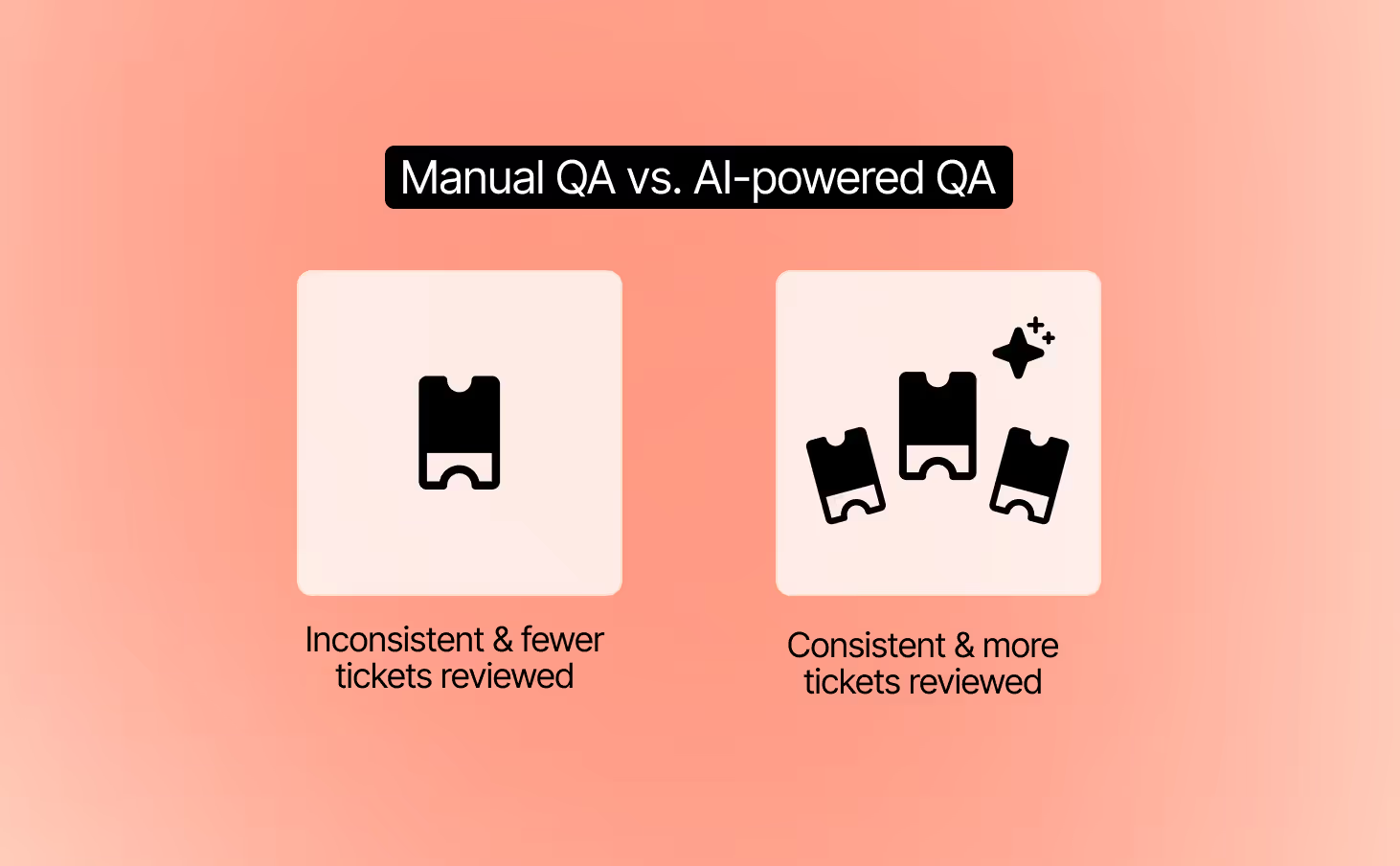
2. Track both agent and AI responses
Customers should get the same level of quality no matter who replies. AI QA evaluates both human and AI conversations using the same criteria. This creates a fair standard and gives you confidence that every interaction meets your brand’s bar for quality.
3. Turn QA insights into coaching opportunities
QA automation is not just about grading tickets. It highlights recurring issues, unclear workflows, or policy confusion. Use these insights to guide targeted coaching sessions and refine AI guidance so both humans and AI deliver better results.
Pro Tip: Pilot your AI QA tool with a small group of agents before peak season. This lets you validate feedback quality and scale with confidence when BFCM volume hits.
Give your ecommerce strategy a boost this holiday shopping season
The name of the game this Black Friday-Cyber Monday isn’t just to get a ton of online sales, it’s to set up your site for a successful holiday shopping season.
If you want to move the meter, focus on setting up strong BFCM automation flows now.
Gorgias is designed with ecommerce merchants in mind. Find out how Gorgias’s time-saving CX platform can help you create BFCM success. Book a demo today.
{{lead-magnet-2}}
Newsletter Signup
The best in CX and ecommerce, right to your inbox
Featured articles

13 Best Live Chat Apps for Shopify in 2025
TL;DR:
- The best Shopify live chat apps combine AI automation with human support so you can instantly handle common questions and escalate complex issues to a real person.
- Try out apps with free trials before you commit, like Gorgias (7-day trial), Tawk.to (free), and MooseDesk (free plan).
- Look for key features like automation, helpdesk integration, and chat-to-human handoff to ensure your live chat can scale with your support and sales goals.
- Roll out chat gradually instead of enabling it everywhere at once. Start with high-intent pages, add automation, and route questions to the right team to keep things manageable.
Thanks to conversational AI, live chat has become a larger shift toward always-on support for Shopify stores. It improves customer experience, helps drive sales, and boosts retention—all while giving shoppers a faster, more personal way to connect with your brand.
In fact, 82% of online shoppers say they’d talk to a chatbot if it meant avoiding a wait. The challenge? Choosing the right live chat app. With over 1,000 options in the Shopify App Store, the search can feel overwhelming.
That’s why we’ve rounded up the 13 best Shopify live chat apps to help you narrow it down.
(Not on Shopify? Explore our best live chat apps for ecommerce or best live chat apps overall instead.)
{{lead-magnet-1}}
Live chat vs. conversational AI—what’s the difference?
Live chat is a way for shoppers to get real-time support from a human agent. The best live chat apps also use automation to handle FAQs, route conversations, or collect details before handing things off to your team.
Conversational AI, on the other hand, goes a step further. Instead of assisting your agents, AI chatbots can carry out entire conversations on their own. They answer questions, recommend products, and resolve issues without human involvement.
Today’s top Shopify live chat tools bring these two worlds together. You get the flexibility of human-led support when it matters most, plus AI agents that scale your availability and keep response times low.
Best live chat apps for Shopify in 2025
- Gorgias
- Zendesk
- tawk.to Live Chat
- O: WhatsApp Chat, Contact Form
- Chatra Live Chat
- Re:amaze Live Chat
- Tidio
- LiveChat
- Shopify Inbox
- Formilla Live Chat
- eDesk Live Chat
- Jotform AI Chatbot & Live Chat
- Moose: AI Chatbot & Live Chat
App |
Pricing |
Helpdesk Integration |
Automation and AI |
Handoffs to Humans |
Ease of Setup |
Language Localization |
|---|---|---|---|---|---|---|
Gorgias |
$10/mo (7-day trial) |
✅ Native helpdesk |
Rules, macros, AI Agent, Shopping Assistant |
✅ Smooth routing to agents |
Easy, no coding |
✅ |
Zendesk Chat |
$49/agent/mo (14-day trial) |
✅ Zendesk Support Suite |
Macros, triggers, chatbots in higher tiers |
✅ Handoffs supported |
Steeper learning curve |
✅ |
Tawk.to |
Free (branding removal extra) |
❌ |
Basic auto-responses, no advanced AI |
✅ Transfer supported |
Easy, no coding |
✅ |
O: WhatsApp Chat, Contact Form |
Free plan + paid tiers (from $2.99/mo) |
❌ No native helpdesk |
Basic automation & preset welcome messages |
✅ Via your linked messaging apps |
Easy, one-click install & widget setup |
✅ |
Chatra |
$31/mo (free plan available) |
❌ |
Typo correction, chatbots (not advanced AI) |
✅ Manual transfer |
Easy, no coding |
✅ |
Re:amaze |
$29/mo (14-day trial) |
✅ Full helpdesk |
Chatbots, rules, macros, workflows |
✅ Integrated with helpdesk |
Easy, no coding |
✅ |
Tidio |
$29/mo (free plan available) |
❌ |
Automation flows, AI chatbot templates |
✅ Transfers to agents |
Easy, no coding |
✅ |
LiveChat |
$16/mo (14-day trial) |
✅ via LiveChat + integrations; not Shopify-native helpdesk |
Chatbots (via add-ons) |
✅ Handoffs supported |
Easy, no coding |
✅ |
Shopify Inbox |
Free |
❌ Limited to Shopify Inbox/Ping |
No advanced AI, basic chat only |
✅ Manual transfer |
Requires Ping app install |
❌ |
Formilla |
$17.49/mo (15-day trial) |
❌ |
Basic automation rules, no advanced AI |
✅ Manual transfer |
Easy, app install |
❌ |
eDesk Live Chat |
$69/agent/mo (14-day trial) |
✅ eDesk helpdesk |
Limited automation, no advanced AI |
✅ Manual transfer |
Easy, app install |
❌ |
Jotform AI Chatbot & Live Chat |
Free (100 convos); Paid $39/mo |
❌ |
AI chatbot trained on store data, integrations with Slack/WhatsApp |
✅ Smooth transitions |
Easy, no coding |
✅ |
Moose (MooseDesk) |
Free plan; Paid tiers available |
✅ Unified helpdesk inbox |
AI chatbot, FAQ builder, auto-translate |
✅ Integrated handoffs |
Easy (PWA, no coding) |
✅ |
1. Gorgias
Gorgias is the best customer experience platform for ecommerce merchants. It provides you with all the features you need to create an incredible customer support experience, improve team performance, and increase sales.
One of Gorgias’s most noticeable features is its tight integration with ecommerce platforms, including Shopify, Magento, and BigCommerce. Hence, Gorgias can pull relevant data like order tracking numbers, last order details, loyalty points, etc., from your Shopify dashboard right to your helpdesk.
Another exciting feature of Gorgias chat is Shopping Assistant, a conversational AI tool that helps support teams increase sales on their website. Using your Shopify catalog, AI can recommend, upsell, and offer tailored discounts at scale so every chat conversation is maximized.
Standout features:
- Compatible with Shopify and Shopify Plus brands
- Affordable pricing plans
- Offers a conversational AI tool that supports and sells
- Fantastic customer support team
Why it may not be for you:
- No free plan
Pricing: Basic plans start at $10/mo. A 7-day free trial is available.
2. Zendesk
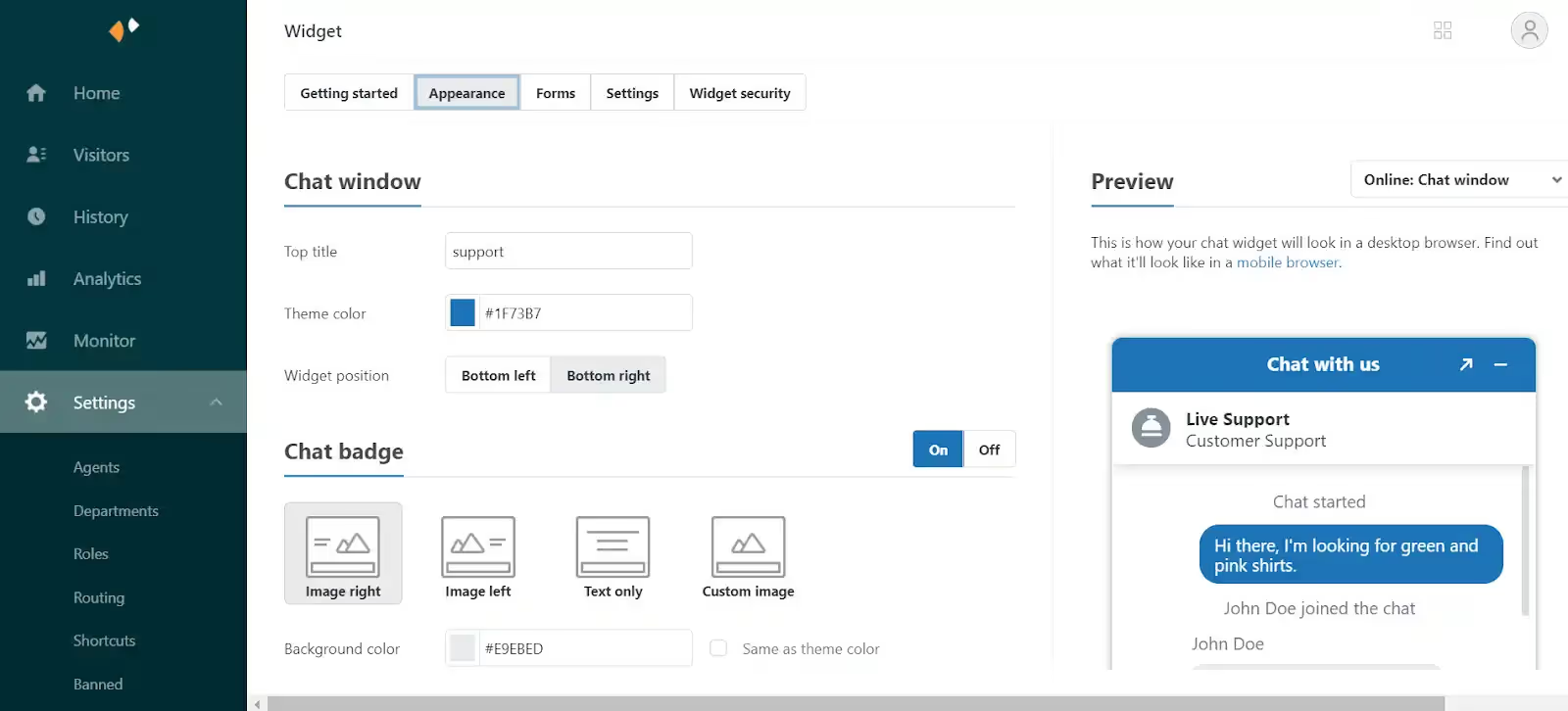
Developed by Zendesk, Zendesk Chat is a live chat app for Shopify stores. It allows you to communicate with customers over your Shopify storefront, mobile apps, and popular messaging apps like Facebook Messenger, Twitter, and Line.
If you’re a Zendesk customer using the Team plan or above, you can use Zendesk Chat for free.
Standout features:
- It’s a good choice if you're using Zendesk Support Suite
- Supports all essential features of a typical live chat app
- Gather customer feedback via chat ratings
- Share files like screenshots, product guides, or GIFs with customers
Why it may not be for you:
- Non-user-friendly interface and steep learning curve for beginners
- Expensive pricing plans for Shopify store owners
- A lot of technical errors when installing and using the app
- Bad customer support team
- Not suitable for ecommerce businesses
Pricing: Starting from $49 per agent per month. A 14-day free trial is available.
3. tawk.to Live Chat
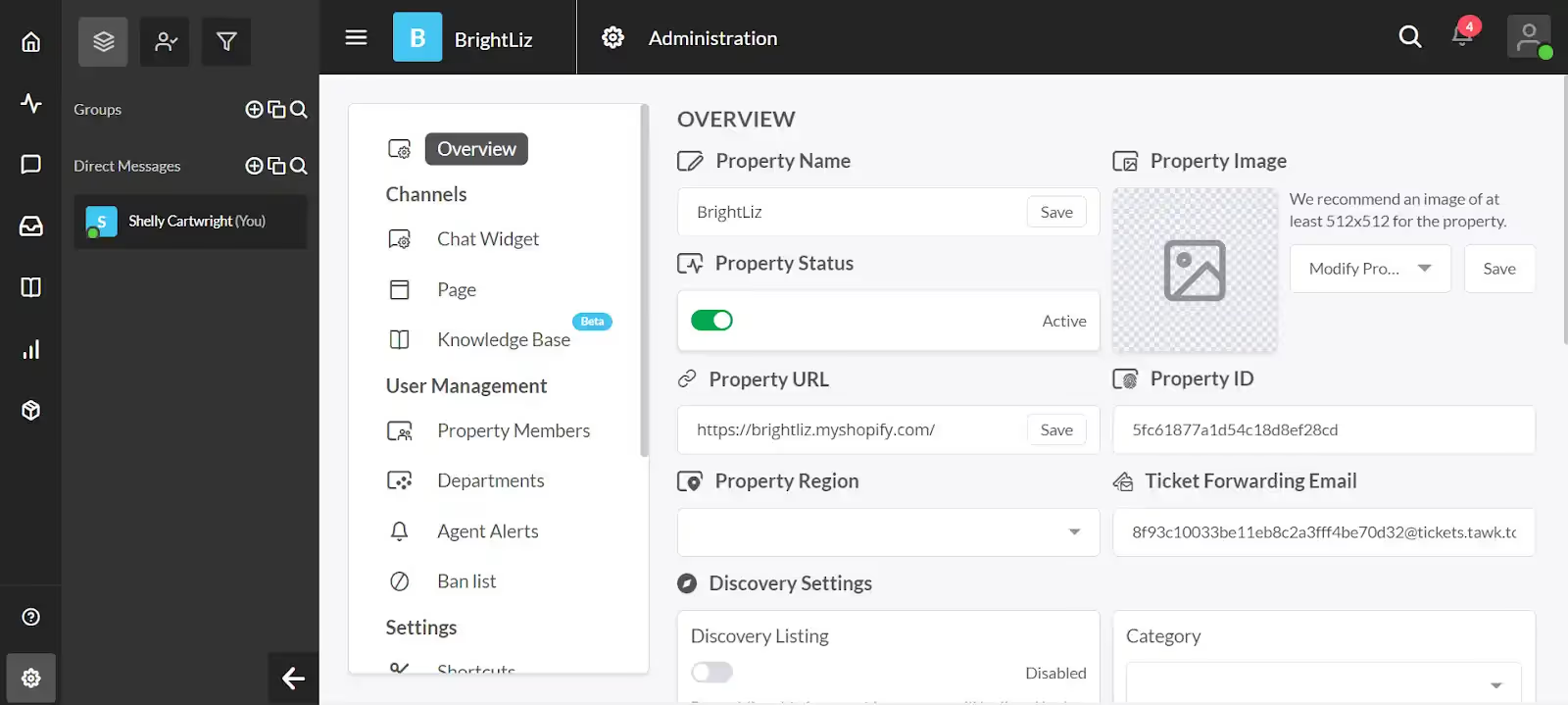
Tawk.to Live Chat is an agent-centric chat application for Shopify stores. The best thing about this app is it’s 100% free—there’s no limit to the number of agents, chat volumes, or sites you can add widgets to.
Standout features:
- Supports 27 languages
- Easy to set up, free forever, and secure
- Available on PC, macOS, iOS, and Android
Why it may not be for you:
- Many features are not user-friendly
- Need to pay a small fee to remove the “Powered by Tawk.to” branding
- The customer support team isn’t always responsive
Pricing: Free
4. O: WhatsApp Chat, Contact Form

O: WhatsApp Chat, Contact Form makes it easy for shoppers to reach you through the channels they already use, like WhatsApp, Facebook Messenger, Telegram, and Instagram. Instead of building out a complex live chat system, it focuses on providing a simple, customizable widget that connects directly to your preferred messaging platforms.
Standout features:
- Integrates with 20+ messaging channels
- Customizable chat button and widget design
- Contact form option for capturing customer details when agents aren’t available
- Targeting rules to show/hide the widget on specific pages or devices
Why it may not be for you:
- Doesn’t offer advanced automation or AI-powered chat
- Lacks ticket management and deep helpdesk integrations
Pricing:
- Free plan available. Paid plans start at $2.99/month
5. Chatra Live Chat
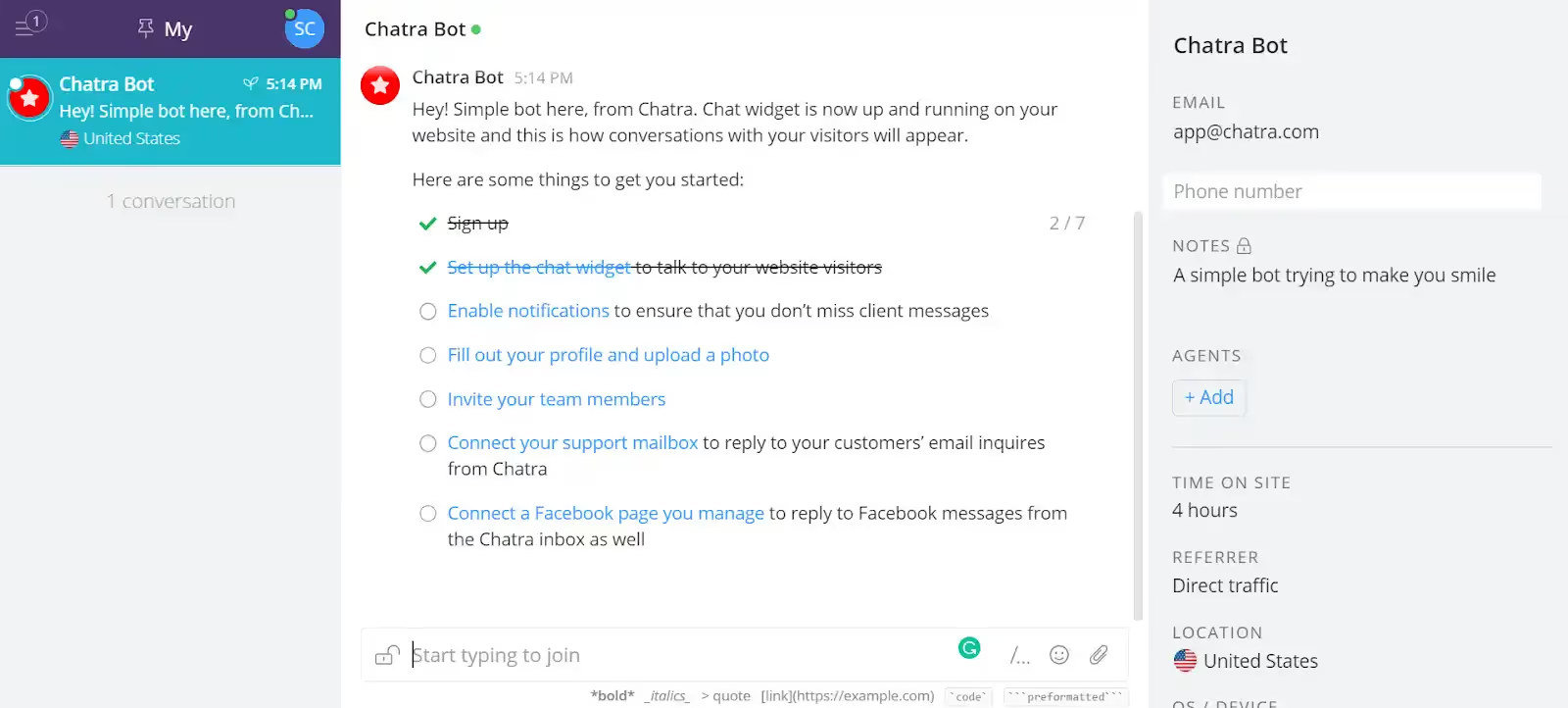
Chatra Live Chat claims to help you “sell more, answer questions, and alleviate concerns to help visitors place an order.” It also allows you to view a shopper's cart contents in real-time to identify the most valuable customers and provide tailored assistance.
Standout features:
- Support a free forever plan
- Provide useful live chat features like typo correction and group chats
Why it may not be for you:
- Most advanced features aren’t available in the free plan
- Lack of customization options
Pricing: Starting from $31 per month. A free plan is available.
6. Re:amaze Live Chat

Re:amaze is a helpdesk, live chat, ticketing, chatbot, and FAQ for small, medium, and enterprise businesses. It allows you to handle support tickets across channels, including emails, live chat, Facebook pages, Messenger, Twitter, Instagram, SMS, VOIP, and WhatsApp.
Reamaze Live Chat aims to help you support customers faster by chatting with them in real-time. It offers many features that are similar to Gorgias’ and other live chat apps.
Standout features:
- Multi-store support
- Can send products to customers in chat
- Flexible pricing, no contract
Why it may not be for you:
- User interface is a bit outdated and not user-friendly
- Macros and rules need improvement
Pricing: Starting from $29 per month. A 14-day free trial is available.
7. Tidio

With approximately 900 reviews, Tidio Live Chat is currently the highest-rated live chat app on the Shopify App Store. Tidio merges live chat, bots, and marketing automation to provide you with a comprehensive live chat app.
Standout features:
- Rich widget customization options
- Many automation and bot templates
- Multiple languages supported
Why it may not be for you:
- Shallow integration with Shopify and other ecommerce platforms
- Pricing plans are a bit high for Shopify merchants
Pricing: Starting from $29 a month. A free plan is available.
8. LiveChat

LiveChat is a messaging app that offers many unique features for its live chat service. It can integrate with most customer relationship management (CRM) tools like Zendesk and ecommerce platforms like Shopify.
Standout features:
- Chat window loads instantly and is easy to use
- Clean and well-designed user interface
Why it may not be for you:
- Not optimized for Shopify since LiveChat is also a CRM
Pricing: Starting from $16 per month. A 14-day free trial is available.
9. Shopify Inbox

Shopify Inbox is Shopify’s native live chat function that allows you to have real-time conversations with customers visiting your Shopify store. It’s an extension to the messaging capabilities already available within Shopify Ping.
Note that all your chats are managed in Shopify Ping. Shopify also asks your customers to provide a phone number or email address in order to start a chat with you. Their information will be added to your Customer list in Shopify or matched to an existing customer.
Standout features:
- Clean and intuitive interface
- Free forever
Why it may not be for you:
- A bit complicated for beginners to install the app
- To use Shopify Chat, you must use Shopify Ping on your desktop (shopifyping.com) or install it on an iOS, iPad, or Android device to receive and respond to messages.
Pricing: Free
10. Formilla Live Chat

Formilla Live Chat offers free live chat and premium services for your Shopify store. You can use this app to chat with your visitors live if they have any questions or need support from your store.
Standout features:
- Easy and simple to use
- Connects with customers quickly
Why it may not be for you:
- Many features locked behind higher plans
- Lack of rules and automation
Pricing: Starting from $17.49 per month. A 15-day free trial is available.
11. eDesk Live Chat
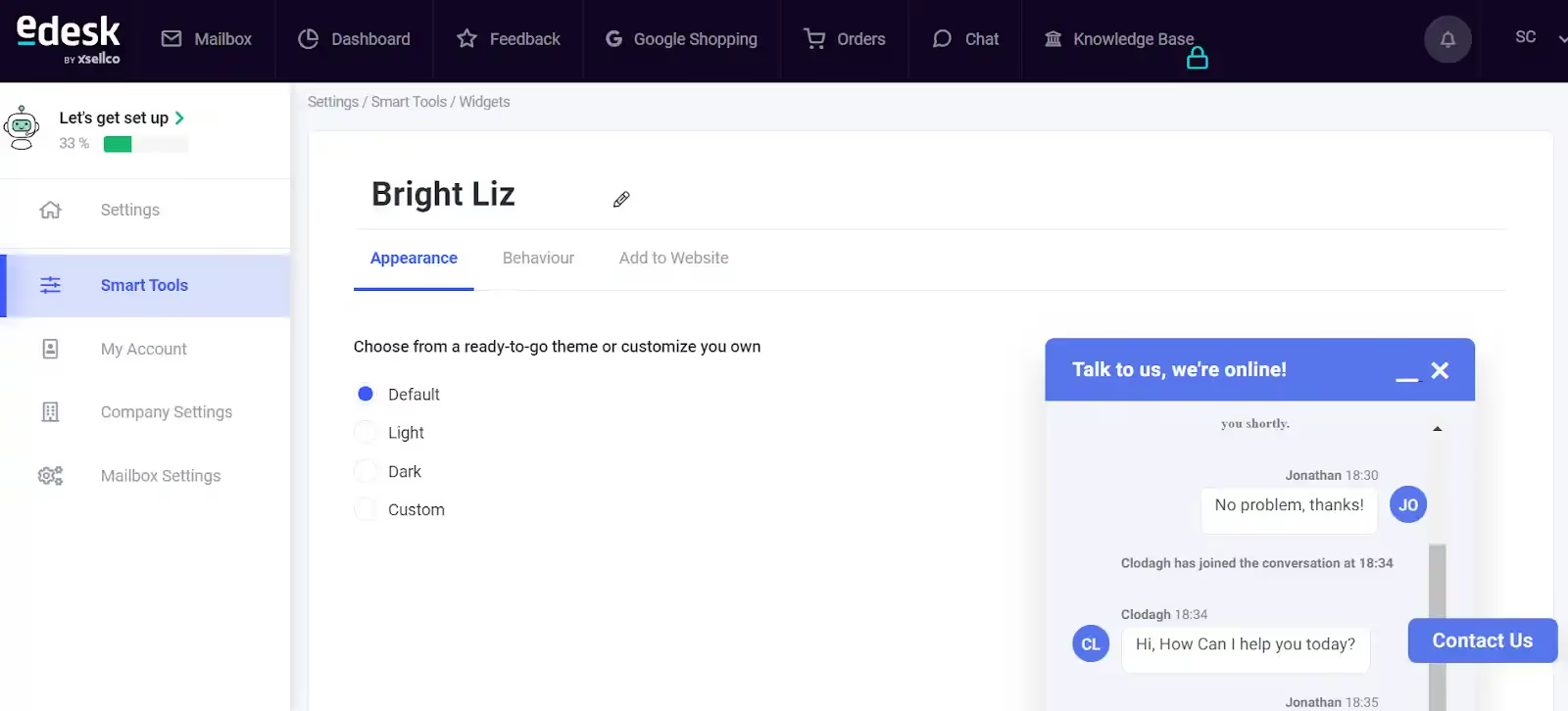
eDesk is a comprehensive customer helpdesk designed for ecommerce. It helps you create a positive experience for customers across your marketing channels: email, live chat, social media, and online store.
Standout features:
- Clean and intuitive user interface
- Good customer service team
Why it may not be for you:
- Pricing plans are steep for Shopify merchants
- Not optimized for ecommerce
- Lack of essential live chat features
Pricing: Starting from $49 per month. A 14-day free trial is available.
12. Jotform AI Chatbot & Live Chat
Jotform AI Chatbot & Live Chat lets you provide 24/7 support with an AI-powered chatbot that integrates directly into your Shopify store. The app automatically trains on your store’s data to answer FAQs, track orders, and even recommend products, while still allowing live chat when a human touch is needed.
Standout features:
- AI trained on your store’s data
- Multi-language support (English, German, French, Spanish, and more)
- Integrations with WhatsApp, Messenger, Slack, and Google Drive
Why it may not be for you:
- Advanced features only available on paid tiers
- More complex than simple live chat apps
Pricing: Free plan available (includes up to 100 monthly conversations). Paid plans start at $39/month with higher limits.
13. Moose: AI Chatbot & Live Chat
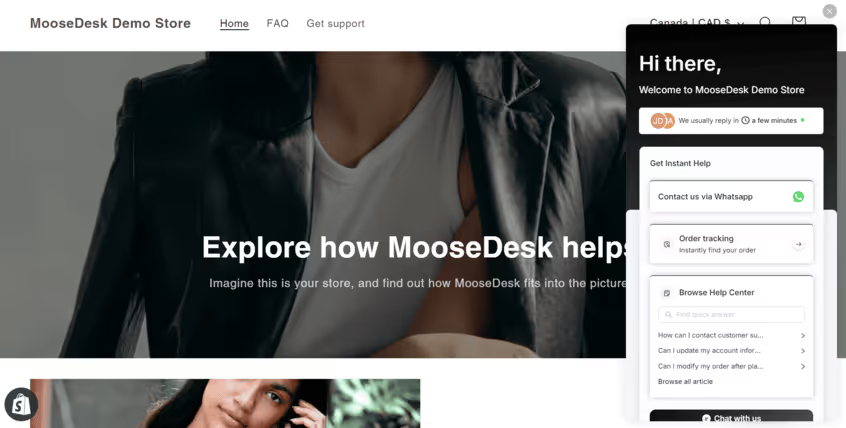
Moose: AI Chatbot & Live Chat (MooseDesk) brings live chat, helpdesk, and omnichannel messaging into one unified tool built for Shopify. With AI-powered automation and support across chat, email, WhatsApp, and social, it's engineered to help you respond faster — without leaving your dashboard.
Standout features:
- Trained on your store data (FAQs, products, etc.)
- Central inbox for live chat, email, WhatsApp, Messenger, Instagram, and more
- Multilingual support and built-in FAQ/self-service features
Why it may not be for you:
- Because it’s a newer tool, some merchants report quirks or missing native mobile app (it's built as a Progressive Web App currently)
- Push notification behavior and instant alerts can vary depending on device settings
Pricing: Free
How to roll out live chat without slowing down support
The benefits of live chat are real, but only if you roll it out with a plan. Too often, brands turn it on everywhere and suddenly face a flood of new tickets their team can’t keep up with. The result is often longer wait times and frustrated customers.
The key is to treat live chat as both a support and sales channel. That means leaning on automation to handle the quick, repetitive stuff, and reserving agent time for higher-value conversations.
Here’s how to strike the right balance:
- Start with automation: Use chatbots to answer FAQs, collect order details, or qualify sales leads before passing them to a human.
- Set smart routing rules: Direct pre-sales questions to your sales team, and post-purchase issues to support, so customers reach the right person faster.
- Limit availability at first: Roll out chat during peak hours or on high-intent pages (like product or checkout) to control volume.
- Layer in human support: Keep agents available for complex or high-stakes conversations where personal service matters most.
By combining humans with automation, you’ll give customers the instant responses they expect, without creating another backlog for your team.
Turn conversations into conversions with the right app
There’s no single Shopify live chat app that works for every store. Each brand has its own support needs, sales goals, and team workflows—which means the “best” tool depends on what you’re trying to achieve.
The smartest approach is to test a couple of the apps above and see which one fits your business best. The right live chat tool should do three things: improve customer satisfaction, make your team’s job easier, and contribute to your bottom line.
And if you’re looking for a solution built specifically for ecommerce? Book a demo with Gorgias as the best Shopify-native option.
{{lead-magnet-2}}

The Updated Gorgias Helpdesk: Built for the Moments that Matter
TL;DR:
- Get instant context with Ticket Summaries. Jump into any conversation without digging through past messages or tabs.
- Organize tickets and customers with Ticket and Customer Fields. Attach properties to tickets and customers to see the whole picture, then turn it into reportable data.
- Support global customers with real-time translations. Engage in natural conversations in your customer’s language without paying for another tool.
- Resolve urgent issues with Priority Scoring. Rank tickets by importance, so high-value or sensitive issues don’t get overlooked.
- Onboard quickly with in-house migration. Whether you’re coming from Zendesk or Richpanel, Gorgias handles the move for you.
We recently unveiled the latest upgrades to Gorgias Helpdesk during Moments that Matter: Meet the Modern Helpdesk.
The event was hosted by Bora Shehu, VP of Product Design, with updates from John Merse (VP of Product), Fraser Bruce (Senior Solutions Consultant), Nicole Simmen (Senior Manager, Customer Implementation), and a customer story from Michael Duran (Operations Manager, Authentic Brands).
From quality of life improvements to brand new features, here’s what’s waiting for you in Gorgias.
Watch the full presentation here:
Support faster with built-in ticket summaries
Agents shouldn’t have to dig for context. Every conversation now comes with Ticket Summaries. Whether an agent has jumped into a ticket mid-conversation or is dealing with a new customer, these AI-generated summaries tell the whole story in no time.
We’ve also given the Customer Timeline a makeover. Now, you can glance at past tickets and order updates in one clean view. Plus, a dedicated Order View lets agents dive into past purchases without leaving the ticket or opening a new tab.
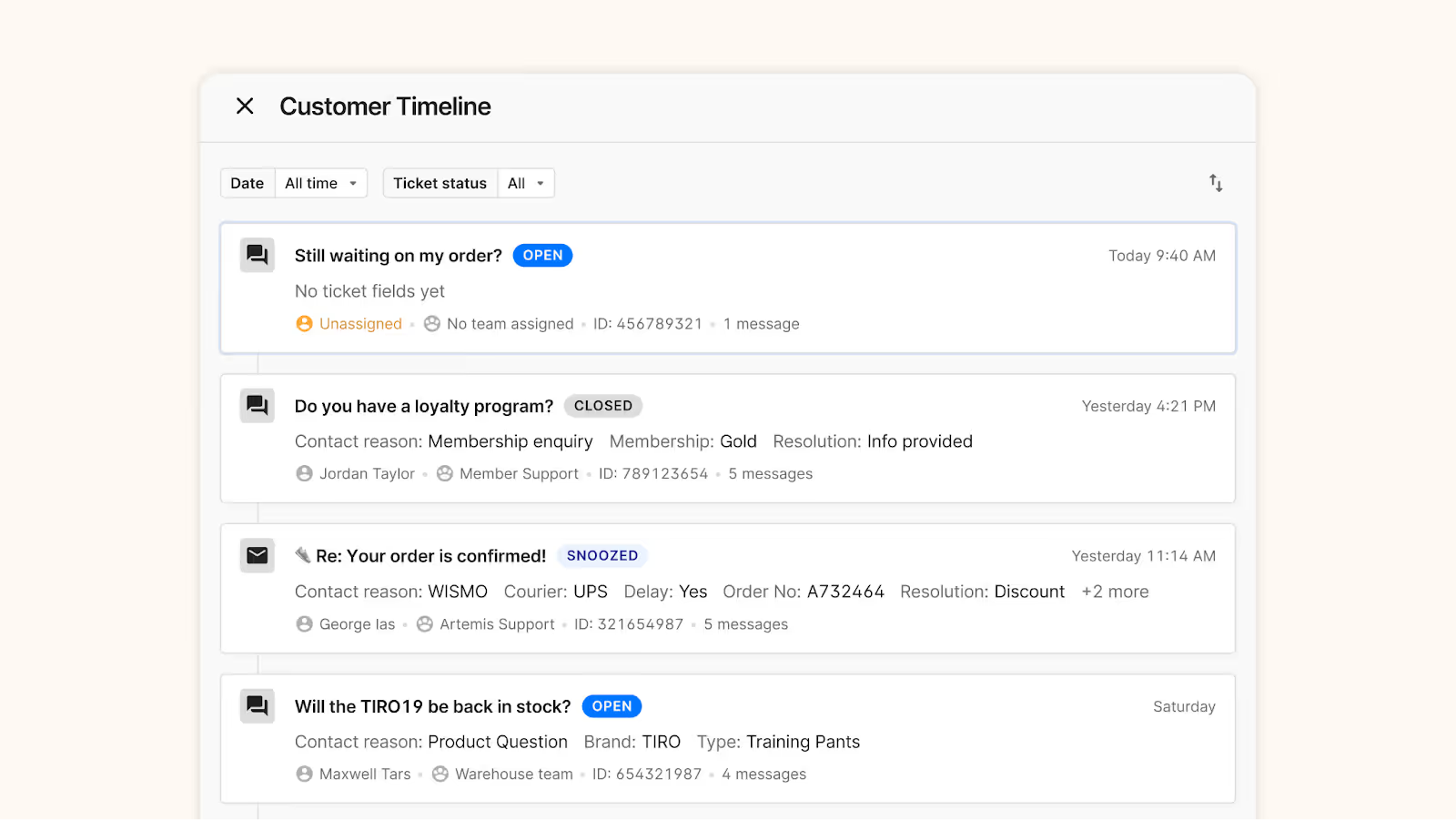
Enrich your data with detailed ticket and customer properties
Agents have always had visibility into customer history, but now that context is easier to act on.
Ticket Fields automatically tags tickets with AI-detected reasons, whether that’s shipping questions or product feedback, to help organize your conversations more effectively.
Then, add in another layer of data using Customer Fields (in beta) to note whether you’re speaking to a longtime, VIP customer or a customer with a history of high returns.
All of this data can be funneled into your ticket reports, making it easier for your team to discover new insights about your products, support quality, and more.

Speak every customer’s language with instant translations
Taking your brand global doesn’t have to mean hiring a whole new team or spending extra on a localization tool. AI-powered translations (in beta) will soon be available on the helpdesk.
Finally, your team will be able to support customers in any language in real-time. Customers write in their native language, agents respond in theirs, and the exchange feels natural on both sides.

Never miss urgent tickets with Priority Scoring
How many times has an urgent ticket been buried at the bottom of your inbox? The new Priority Scoring system prevents that by automatically labeling tickets as Low, Normal, High, or Critical based on your Rules.
For example, you might label a negative Facebook comment with threatening sentiment as ‘High,’ or bump high-value shoppers to the top with a ‘Critical’ label. This ensures your team always sees the conversations that need the most attention, so no sensitive issue slips through the cracks.
Shape every call journey with the new IVR flow builder
Now in beta, our flow-based IVR (interactive voice response) system lets teams on Gorgias Voice build customized call journeys for every type of conversation. Route customers through interactive menus, segment them based on their data, or direct them to voicemail, and schedule SMS follow-ups and callbacks.
To match agent availability, you can set business hours per phone number and per channel across storefronts. Teams also have more flexibility with ring strategies (ring available agents all at once or one at a time), wrap-up time between calls, and faster availability refreshes.
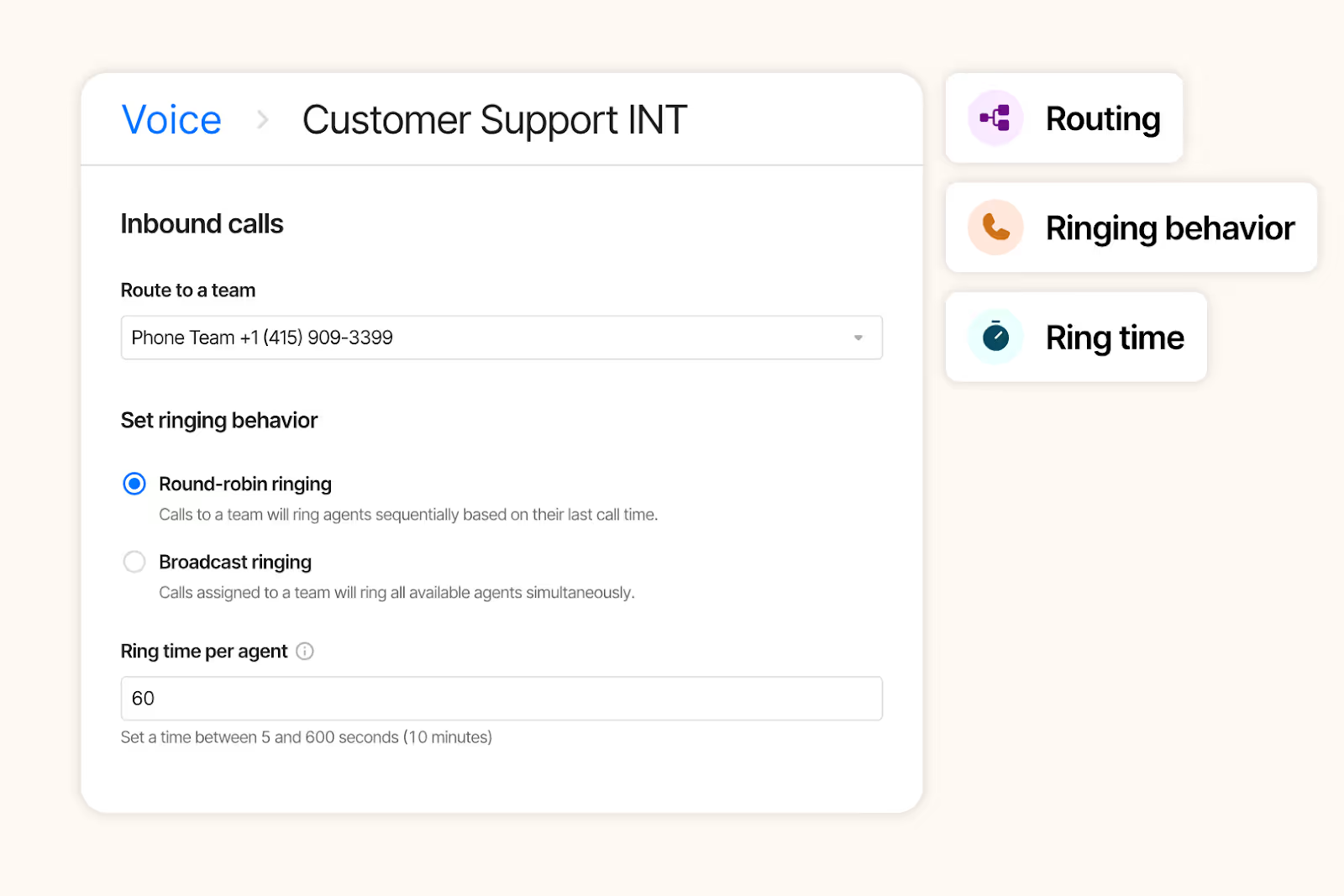
Stay on top of every goal with custom dashboards
We understand that CX teams need more than surface-level KPIs—they need to know what’s actually driving performance, revenue, and retention.
With Dashboards, you can build reports focused on CX data you care about, from agent performance to product return trends. Then, filter by store or sub-brand to zoom in on the details each team is responsible for.
We’re also introducing the Human Response Time metric to show how quickly your team responds to escalations from AI Agent. This gives you a clear sign of what issues require human attention, how fast they’re resolved, and whether you need to adjust staffing.
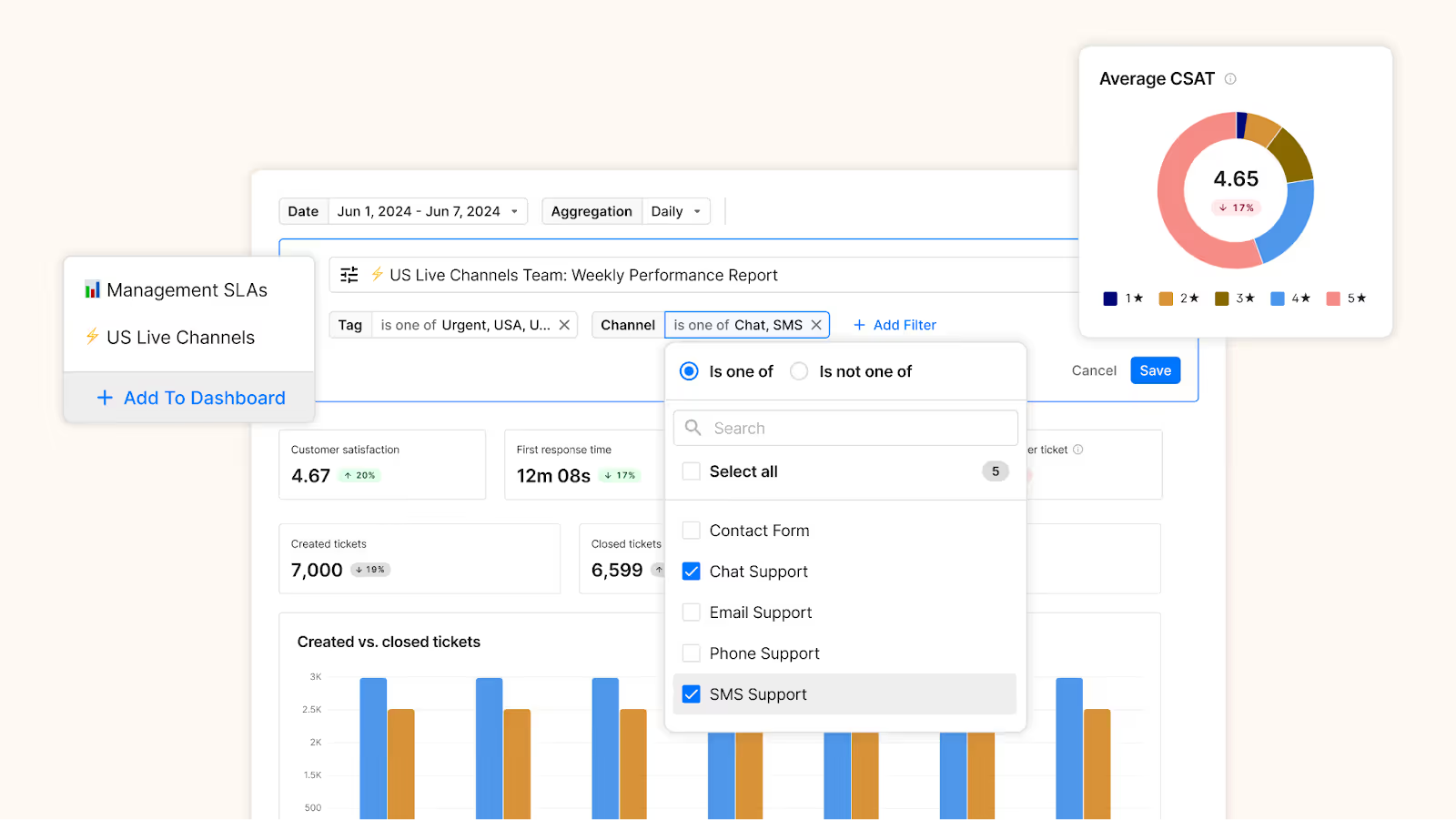
Effortless, in-house migration for new joiners
Leave the moving to us—we now manage migrations in-house. Depending on your plan, our Implementation team will transfer emails, customers, macros, and more for you. Combined with 99.99% uptime, switching platforms is smoother, faster, and more reliable than ever.
For accelerated performance, consider our 50-in-50 implementation program, which aims to resolve 50% of your ticket volume using AI Agent within 50 days.
Enterprise customers receive a dedicated Enterprise CSM, optimization workshops, and 24/7 support to get the most out of Gorgias from day one.
What’s coming next
Our teams are hard at work changing the landscape of customer experience. Here’s what’s on the Gorgias Product Roadmap:
- Cleaner, minimal interface. We’re giving our UI a new look to reduce clutter and highlight key information, making conversations front and center.
- Detailed order view. Quickly view past purchases and make order updates without opening new tabs or interrupting your workflow.
- Shop right in chat. Soon, product photos, descriptions, and even customer reviews will be shown directly in Gorgias Chat, so shopping experiences are as frictionless as possible.
- Scheduled CSV exports. Prove the value of CX with automated exports, perfect for stakeholders, whether they use Gorgias or not.
- New integration with Assembled Workforce Management. Our partnership will help you leverage Gorgias ticket data to optimize forecasting and agent scheduling.
- Role-based access control. Decide which dashboards, views, conversations, and settings can be accessed by each user role.
- Okta single sign-on. Let your team sign in to Gorgias using the same authentication service you use for the rest of your tech stack.
The future of support starts with your helpdesk
Our latest helpdesk updates make it easier than before to create memorable customer moments.
As Bora Shehu, our VP of Product Design, said, “We hope that the tools we’re building help you spend less time on robotic work, and more time on impactful human work that grows your businesses through the power of conversations.”
If you’re not on Gorgias yet and want to see what’s possible, book a demo today.
{{lead-magnet-1}}
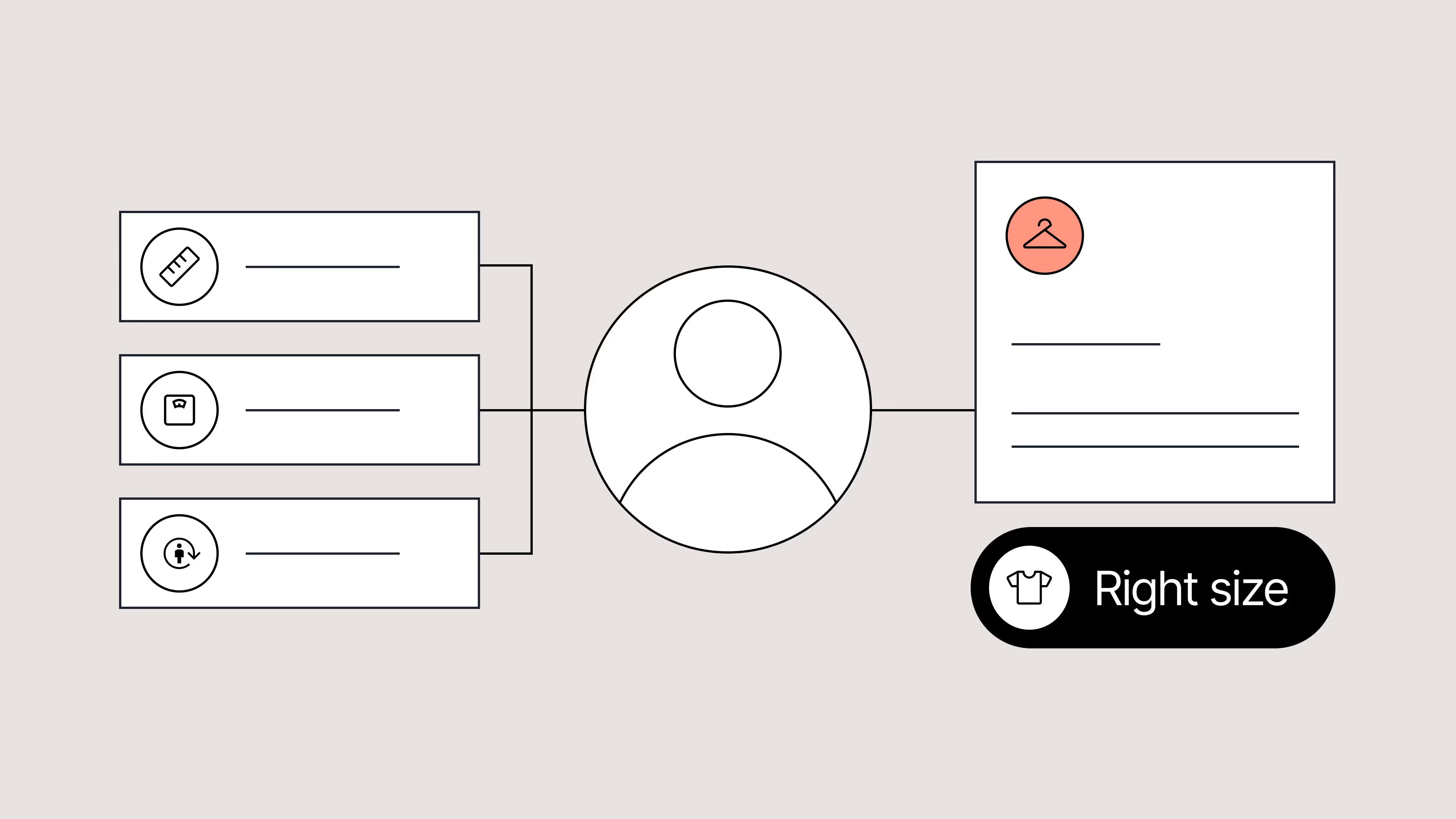
How Online Sizing Solutions Are Replacing the Fitting Room
TL;DR:
- 58% of fashion shoppers “bracket” orders—buying multiple sizes and returning what doesn’t fit. This drives high return rates, increased costs, and customer frustration.
- 70% of returns are due to sizing issues. Nearly half of shoppers abandon carts over inconvenient returns.
- Leading solutions include: AI-powered fit tools, 3D visualizations that show scale and model stats, “fit finder” tools, at-home fitting experiences, and AI-powered customer support.
- Brands that replicate the fitting room online gain higher retention, lower costs, and stronger sustainability.
Sizing has long been a friction point for ecommerce fashion shoppers.
Without the ability to try items on, 58% of shoppers resort to "bracketing"—ordering multiple sizes of the same piece and returning what doesn’t fit.
While it gives customers a temporary fix, it ultimately creates frustration for them and logistical headaches for brands.
The result is rising return rates, higher costs, and wasted resources. To break this cycle, ecommerce brands need to rethink how they guide shoppers toward the perfect fit. The good news is that many brands are already showing the way by using AI-powered tools and smarter product experiences to replicate the fitting room from the comfort of home.
{{lead-magnet-1}}
Returns are getting unsustainable
Recent data highlights just how severe the return challenge has become for fashion and apparel retailers:
- 46% of shoppers have abandoned a purchase because return methods were inconvenient.
- Fashion and apparel brands get twice as many return requests than any other industry.
- According to Gorgias data, 70% of returns are due to sizing confusion.
- “Will this fit me?” is one of the top reasons customers contact support.
In addition, rapidly rising concerns around sustainability and climate change, as well as heightened awareness around over-consumption, are prompting consumers to make changes in their purchasing habits.
Brands who prioritize well-fitting, long-lasting pieces and reduce carbon footprints and the amount of clothing diverted to landfills by lowering returns can actually benefit from a strategic edge.
“Those who choose to approach sustainability with a long-term mindset even while battling short-term problems will be rewarded with more efficient business operations and a competitive advantage,” writes McKinsey in its State of Fashion 2025 report.
Effective sizing solutions for ecommerce brands
Most brands already have size charts, but shoppers don’t want to measure themselves, or find those charts to be inaccurate.
When shoppers lack confidence in choosing the right fit, they either abandon their carts or rely on bracketing, both of which lower profitability and customer trust.
Forward-looking fashion and apparel brands are solving sizing issues by using tools for a more intuitive shopping experience. This ultimately helps them build loyalty, increase retention, and reduce returns.
Implement AI-powered body measurement tools
Rather than purely providing static size charts on your website, opt for AI-generated personalized fit recommendations instead.
For example, European fashion retailer Zalando reduced size-related returns by 10% using AI-driven advice.
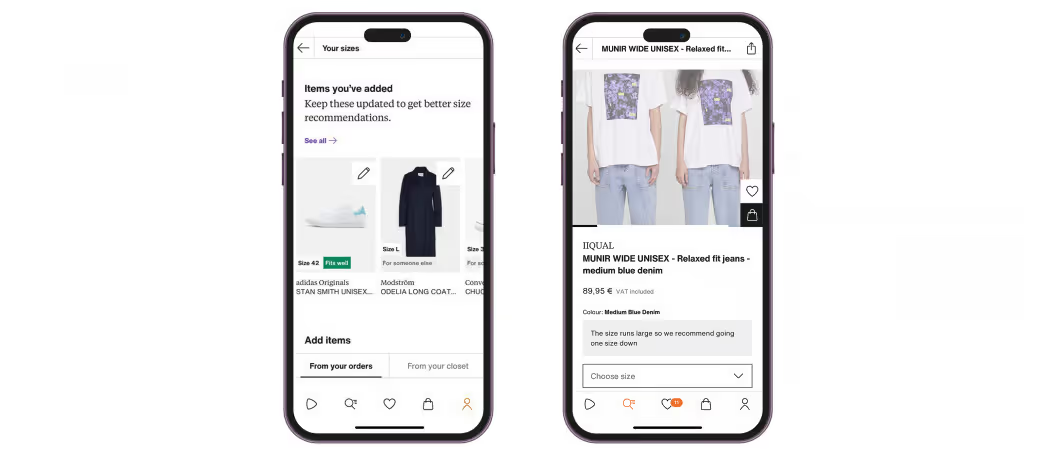
The brand flags whether an item is true to size or not. It also offers the ability for customers to see recommendations based on logged fit-based return reasons, past purchases, and other clothing items that fit them well.
Zalando also launched a body measurement feature in 2023 where shoppers can actually scan themselves for more accurate size advice.
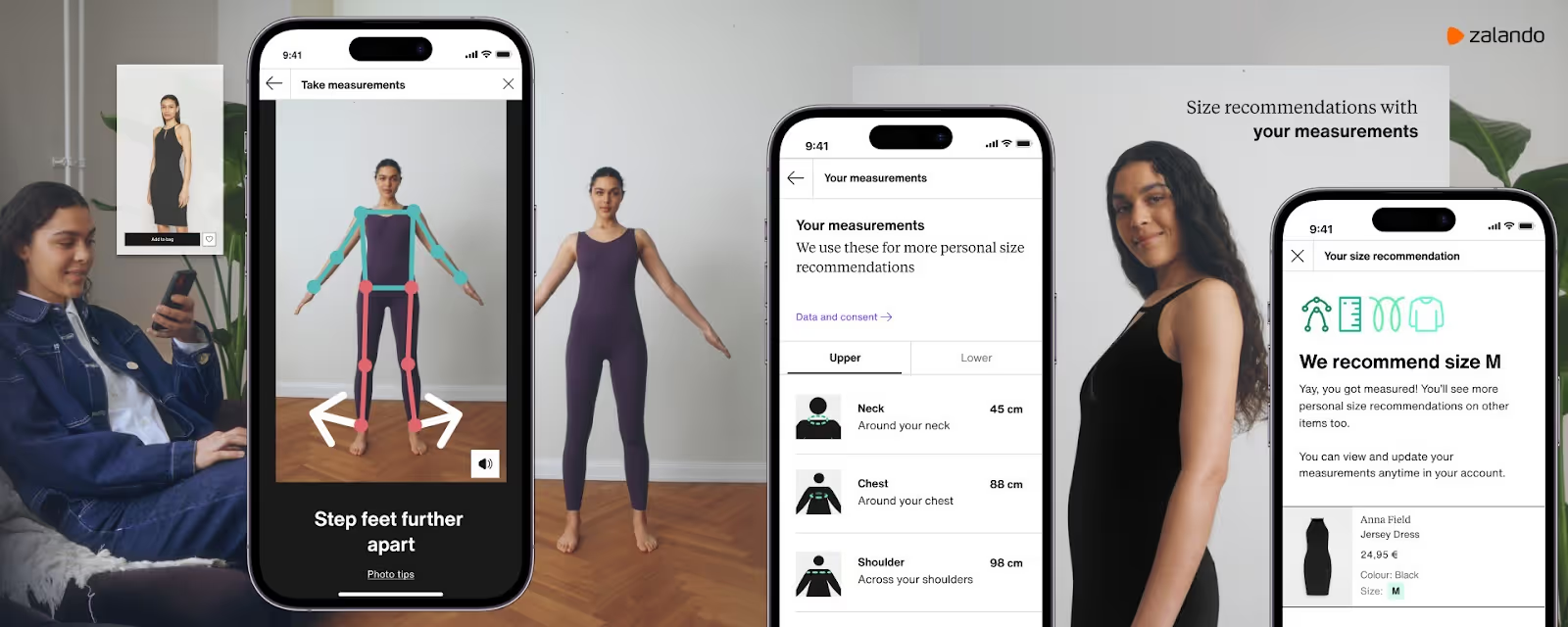
Show size and scale in product photos
As AI grows in proficiency, there are more tools than ever to help shoppers visualize product scale and fit.
For example, accessory shop LeSportsac uses Tangiblee, a product experience tool, to help customers understand scale and what fits inside each bag.

Performance hunting gear shop KUIU takes another approach. It uses a photo-based layering guide, so shoppers can see how the size and fit look with multiple layers on a model. Different model stats shown within product photography give contextual sizing cues.

Sleep shop Cozy Earth takes a similar route, stating model height and size on product photos.
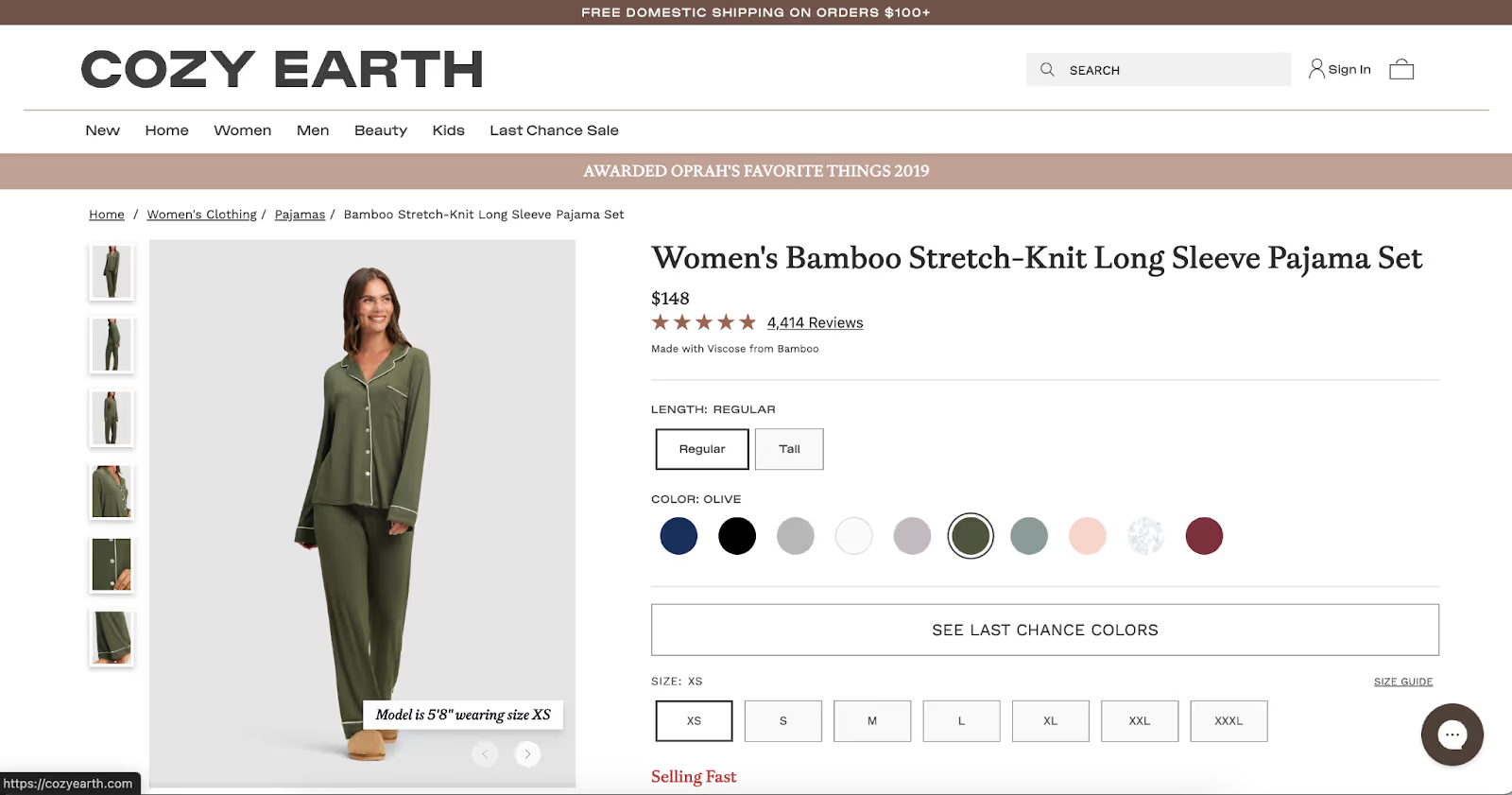
Introduce “fit finder” tools
Some brands are helping shoppers pick the right size with interactive quizzes based on factors like height, weight, and the sizes of other clothing items that fit well. SuitShop is among those brands using a Fit Finder quiz on its website.

Similarly, Psycho Bunny leverages the AI tool True Fit as a size finder on product pages.
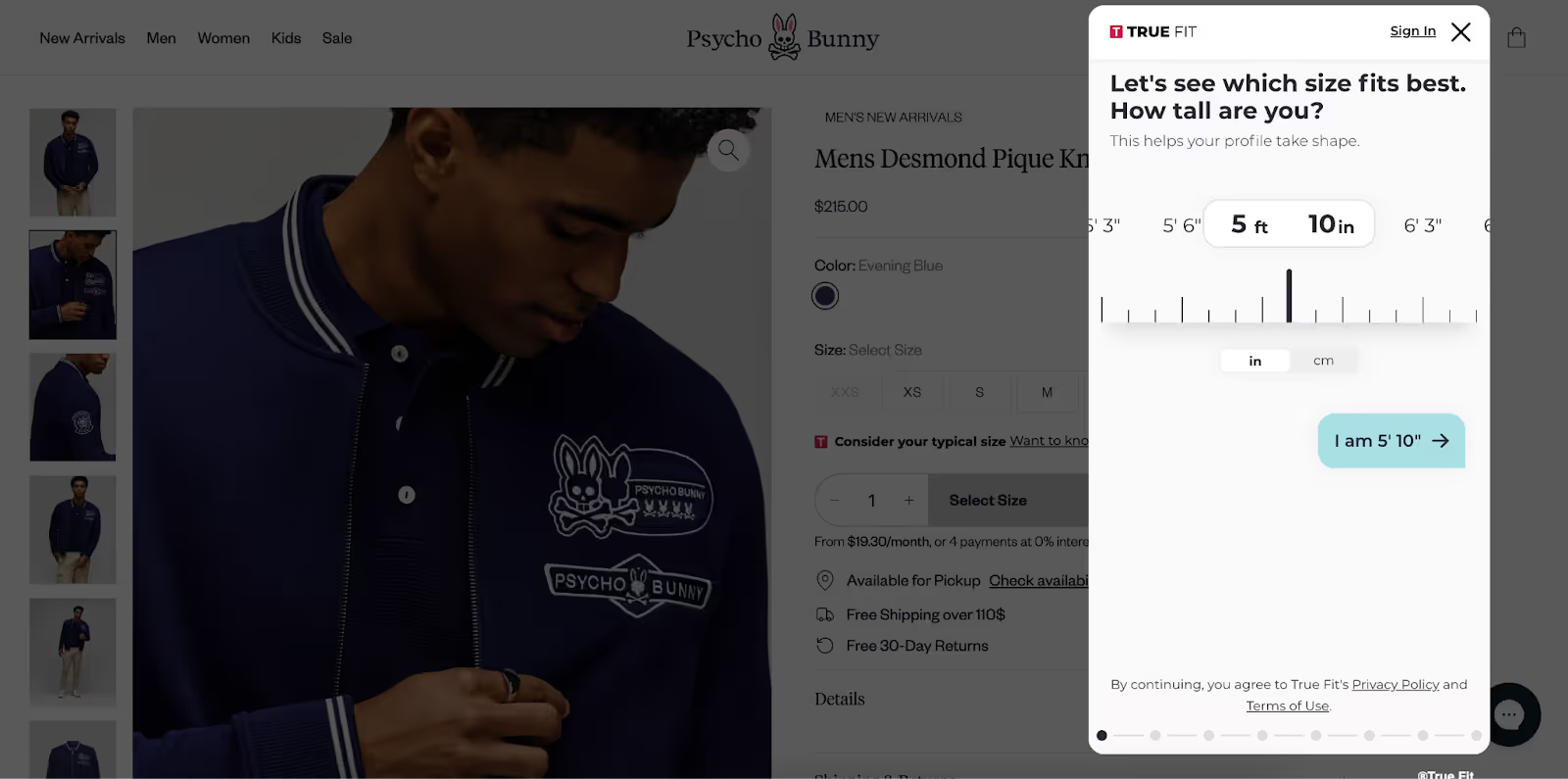
Bring the fitting room home
Ergonomic shoe brand Orthofeet eliminates sizing qualms altogether by including customizable inserts inside each box. Fitting spacers ensure a snug fit and arch enhancement for those who need it, helping shoppers get comfortable shoes that fit.

Jonas Paul Eyewear shares the “try it on at home” approach, offering a free or low-cost home try-on kit.

Leverage AI-powered customer support
Gorgias Shopping Assistant helps brands meet that need by delivering human-like guidance at scale, giving shoppers instant answers that feel personal.
For example, VESSEL uses Shopping Assistant in chat to provide real-time support on sizing and inventory, helping customers choose with confidence. By addressing fit questions directly, Shopping Assistant reduces returns and builds trust at the point of purchase.

Similarly, outdoor clothing retailer Arc‘teryx provides an “ask me anything” AI chat where shoppers can confirm any questions they have around fit or sizing.
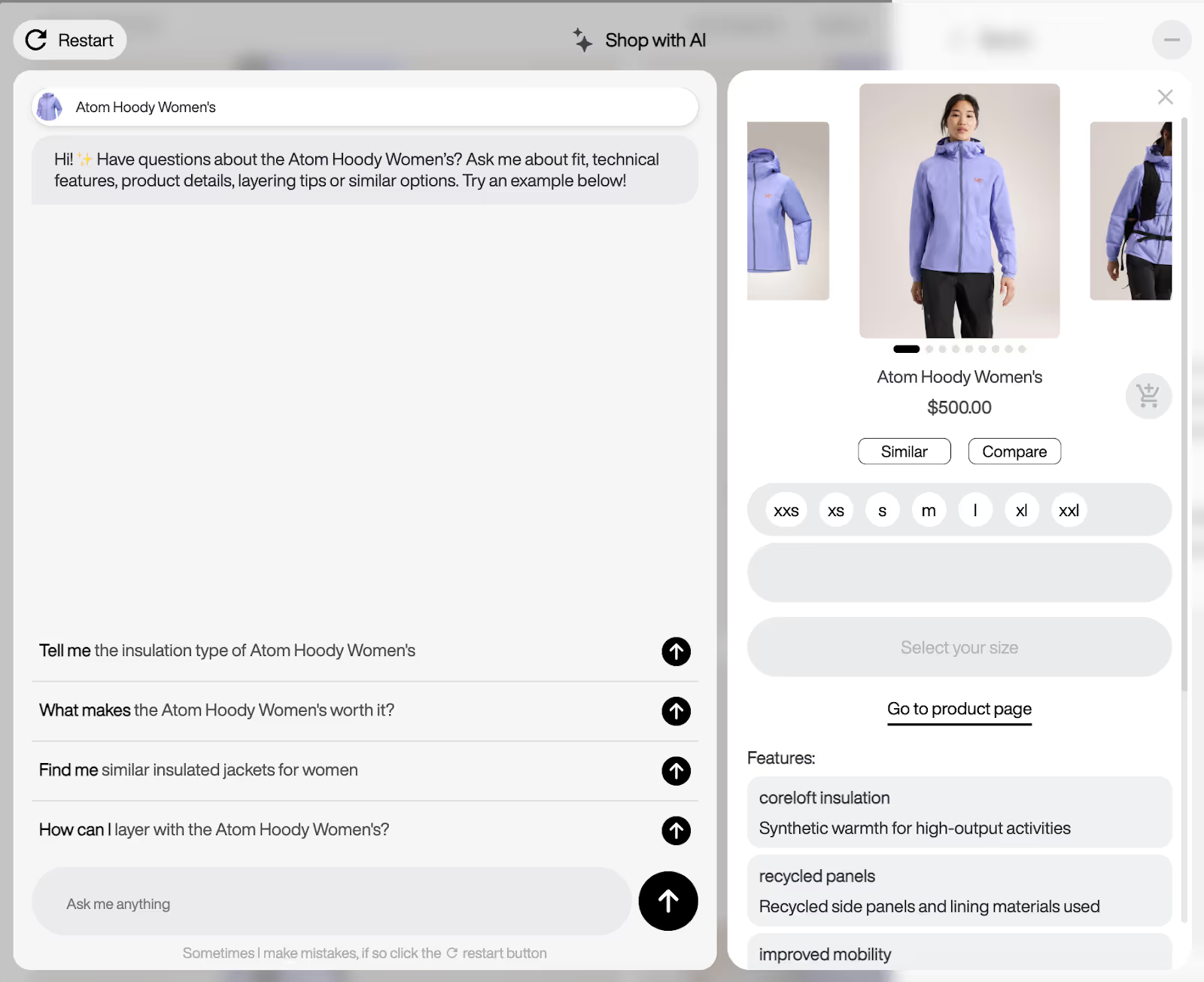
The future for ecommerce size guides
Sizing for ecommerce fashion and apparel brands has become a business-critical challenge. With 70% of returns tied to fit issues and nearly half of shoppers abandoning purchases over inconvenient returns, brands that replicate the fitting room online stand to gain a competitive advantage.
From Zalando’s 10% reduction in size-related returns to VESSEL’s use of AI-powered chat, the path is clear: investing in smarter size chart solutions pays off with higher retention, lower costs, and stronger sustainability.
The brands that provide fitting room-level experiences online now will set themselves apart from the rest.
Book a demo to see how Gorgias, the leading conversational commerce platform, helps fashion brands cut returns, drive sales, and deliver fitting-room level experiences online.
{{lead-magnet-2}}
Further reading

Coach AI Agent in One Hour a Week: SuitShop’s Guide
TL;DR:
- Don't just turn it on, coach it. Treating your AI Agent like a team member, not a plug-and-play tool, is what makes it truly helpful and memorable.
- One owner and one hour a week is enough to make a big impact. SuitShop’s Katy Eriks runs QA and training solo, using a repeatable system to log feedback and improve performance weekly.
- Don't forget to pause and evaluate. SuitShop temporarily turned off AI to improve their help content, making automation far more effective when it came back online.
- Let your best human agents guide your AI. Katie studied her top-performing teammate's tickets to teach AI the best responses and macros.
- Brand voice matters as much as accuracy. SuitShop's AI Agent "Max" is trained to sound warm, helpful, and on-brand. Customers even thank it by name.
The most coachable team member on your support team might not be human.
Brands that want to keep up with rising customer expectations are turning to AI to help meet demand. But as SuitShop’s Director of Customer Experience, Katie Eriks, will tell you, great results don’t come from flipping a switch.
They come from coaching.
Since implementing Gorgias AI Agent, SuitShop has reached a 30% automation rate, all while maintaining a lean CX team and giving every customer the tailored experience they expect (literally and figuratively).
“I consider myself its boss,” said Katie, who runs the entire coaching process solo. With under an hour of weekly maintenance now, SuitShop’s AI Agent runs efficiently, accurately, and on-brand.
Katie spoke at Gorgias Connect 2025 to share exactly how she got there. You can watch her full session below:
The case for coaching your AI Agent
When brands think about automation, they often imagine flipping a switch and watching repetitive tasks vanish. But in practice, it’s not that simple, at least not if you care about customer experience.
Gorgias encourages brands to treat their AI Agent like a junior teammate — someone you onboard, train, observe, and coach over time.
Brands that do this well are already seeing massive gains:
- 60%+ of customer conversations fully automated
- First response times under 30 seconds
- Consistent CSAT scores of 4.5 and above
- Major cost savings during high-volume seasons
For SuitShop, automation was about creating space for their small team to focus on specialized service. Space to scale without scaling headcount. And space to do it all without losing their voice.
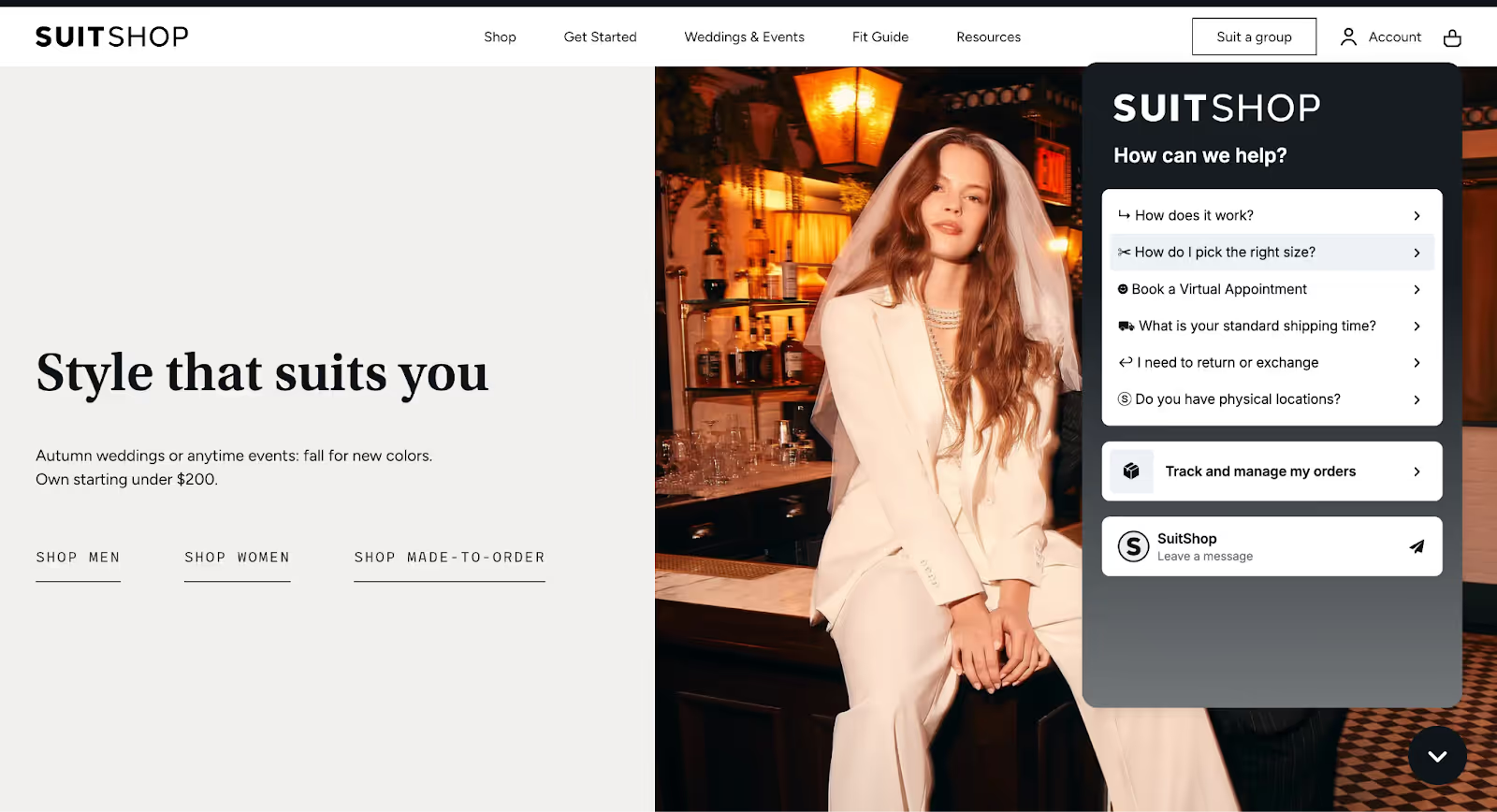
Step-by-step: SuitShop’s AI coaching workflow
Katie and her team had been longtime Gorgias users, but when they turned on AI Agent in August 2023, the results were unremarkable. The responses weren’t inaccurate, but they weren’t helpful enough either.
What Katie learned was to “Be hands-on early. Use downtime to train. And never stop refining.”
So she got to work, not by replacing the tool, but by going deeper into it. Here are her coaching tips:
One owner, one hour a week
Katie made herself the sole point of contact for training and QA. That might sound like a lot, but over time, it became a light lift.
“At this point, it’s definitely less than one hour per week,” she said. “In the beginning, it was more time-consuming because I needed to create help center articles and Guidance regularly. Now I’ve got it down to a pretty quick thumbs-up, thumbs-down kind of process.”
Katie uses Monday mornings to review AI Agent tickets from over the weekend, when fewer human agents are available and AI takes the lead.
Read more: Why your strategy needs customer service quality assurance
Pause and perfect before scaling
Unlike many retail brands, SuitShop’s busiest time isn’t the holiday rush — it’s wedding season in the summer and fall. So when things quieted down in December, Katie used that time strategically.
She temporarily turned off the AI Agent to regroup.
“I decided to turn it off and really beef up our Help Center,” she explained. “I went back to the tickets I had to answer myself, checked what people were searching in the Help Center, and filled in the gaps.”
She built out content with a mix of blog knowledge, internal macros, and ChatGPT. Once she felt confident the content base was solid, she turned AI back on.
Read more: How to optimize your Help Center for AI Agent
Use data to guide your coaching plan
Once SuitShop’s foundational content was in place, Katie didn’t just sit back and hope for the best. Instead, she built a repeatable feedback loop grounded in data — one that helped her spot opportunities for improvement before they became issues.
Rather than combing through tickets at random, Katie created custom views inside Gorgias to zero in on the most impactful coaching moments:
- Low CSAT tickets: Any conversation that ended with a customer satisfaction score below expectations got flagged. These were clear indicators that something about the tone, accuracy, or clarity of the AI response had fallen short.
- High handover rates: Katie looked at the tickets AI Agent was regularly handing off to humans. Many of these were actually answerable. The handover just meant that guidance was missing, miscategorized, or too vague.
- Agent-tagged tickets: To make this scalable, Katie empowered her team to flag any strange or impressive responses from the AI. By using a tag like AI_agent_feedback, team members could drop tickets into a coaching queue without needing to write a full explanation.
To keep all of this actionable, Katie logs insights in a shared spreadsheet that functions as a live to-do list. Every row includes:
- A link to the ticket
- A summary of the issue
- The resolution (e.g., new Guidance or macro needed)
- A status tracker (not started / in progress / completed)
- A link to the resource she created in response
These insights are also available in Gorgias’s dashboard, where you can identify the top issues customers had.
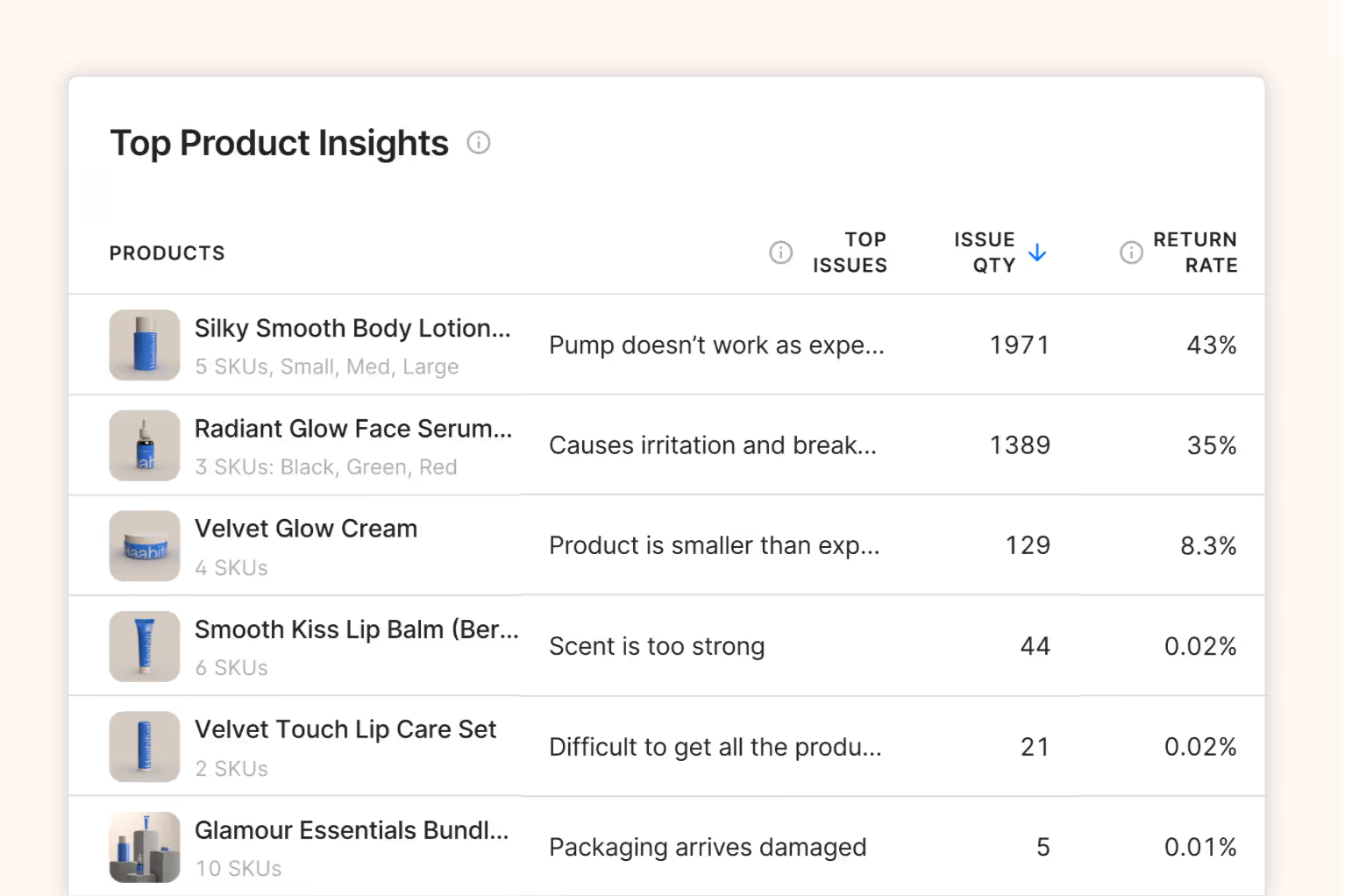
“Sometimes I do it all in the moment. Other times I’ll log it and come back later when I can take the time to do it right.”
By combining frontline feedback with structured ticket views, Katie turned scattered QA into a consistent coaching system — one that ensures SuitShop’s AI Agent keeps getting smarter every week.
Learn from your human agents
One of Katie’s most effective strategies comes from her own team.
Like many CX leads, she noticed that some agents consistently resolved tickets in a single touch. That pattern, Katie realized, wasn’t just a win for customers, it was a roadmap for an AI-driven support strategy.
Her teammate Tacy quickly became her go-to signal for what the AI Agent needed to learn next.
“I pull her tickets often to see what she’s responded with. It helps AI learn from her directly.”
By reviewing Tacy’s ticket history, Katie identified standard replies that didn’t yet exist as macros or Guidance. If Tacy was writing the same sentence repeatedly or copy-pasting a reply manually, that meant it could (and should) be taught to the AI Agent.
She also tracked Tacy’s macro usage rate. If Tacy frequently used a macro for a certain issue, but other agents weren’t, it flagged an opportunity to standardize responses across the team and the AI.
The key insight? If it only takes one touch for a human to answer, the AI can be trained to do it too.
These small efficiency wins added up quickly, especially during peak season, when the ability to automate just a few extra conversations per day created meaningful breathing room for the rest of the team.
Related: How to automate half of your CX tasks
Make your AI sound human (and on-brand)
Automation without brand voice feels robotic. Katie made sure SuitShop’s AI Agent sounded like a natural extension of the team, and that started with a name: Max.
“We get replies like, ‘Thanks Max!’ from customers who think it’s a real person.”
Using AI Agent’s tone of voice settings, Katie went deep on personalization. She customized everything from sentence structure and greeting format to whether or not emojis and exclamation marks should be used (they shouldn’t, in SuitShop’s case).
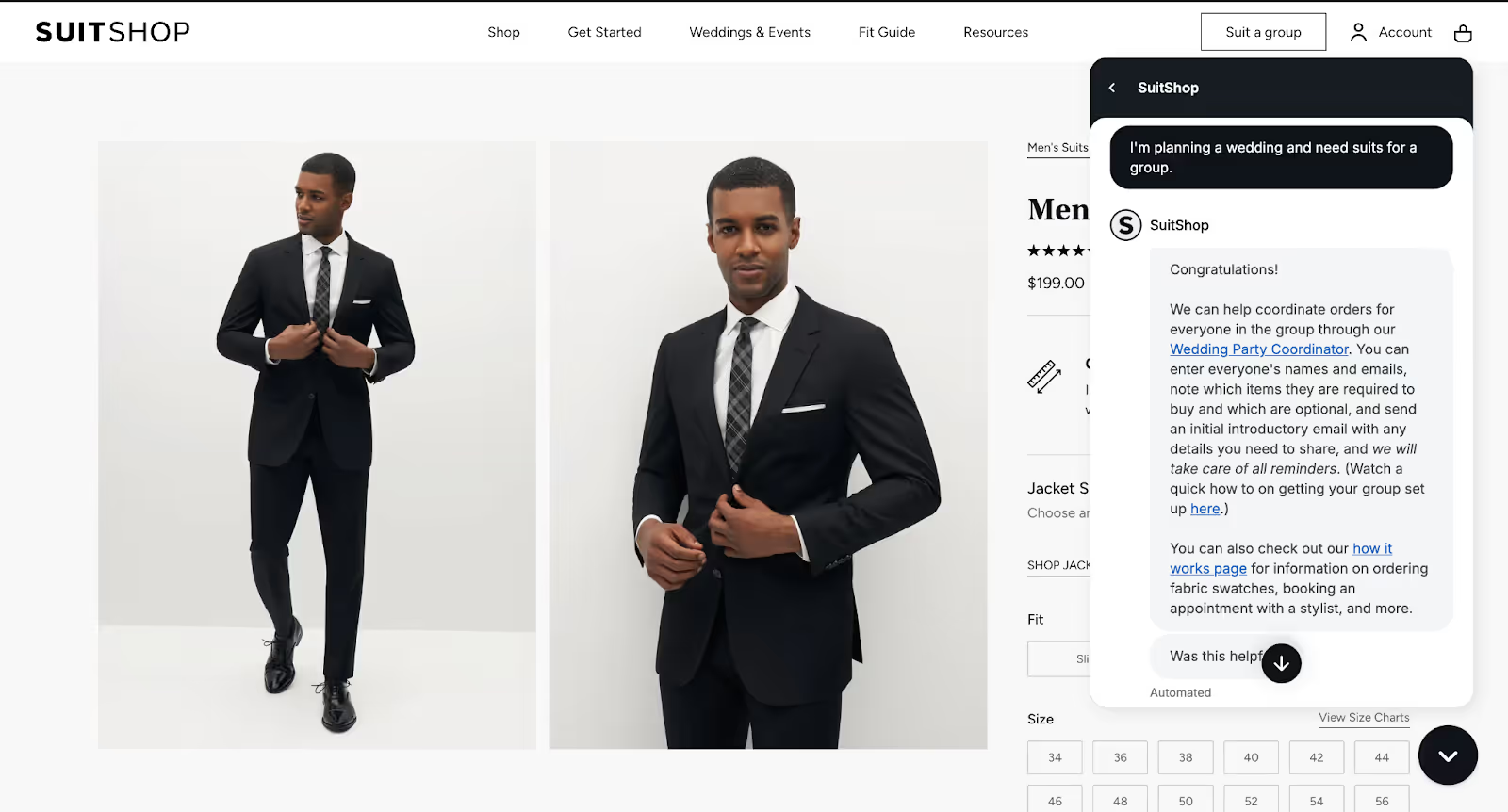
Her AI Agent instructions include clear direction on:
- Tone: Warm, empathetic, clear, especially with high-stress wedding-related issues
- Structure: Shorter responses for chat, slightly more detailed for email
- Dos and Don’ts: Specific words or phrases to use or avoid, pulled from real team responses
- First/last name use: Always first name only, to keep things friendly but respectful
Katie also made sure she instructed AI Agent to acknowledge customer emotions — especially frustration — and to offer reassurance when things went wrong.
And because AI responses are written at lightning speed, she regularly reviewed messages to ensure they didn’t come off as cold or abrupt, especially in sensitive situations like delayed wedding orders or size issues close to the event date.
Live coaching: What it looks like in practice
In the workshop, Katie walked through two real support tickets where AI missed the mark and how she used those moments to improve.
In one case, a customer asked a common question: “The navy suit I’m looking at says ‘unfinished pant hem.’ Will the pants need to be hemmed?”
Despite having help articles and macros explaining this exact issue, AI Agent responded: “I don’t have the information to answer your question.”
That was a red flag.
Katie immediately stepped in to coach the agent by:
- Applying the correct existing resources
- Writing an ideal sample reply as an internal note
- Checking tone, empathy, and phrasing
- Testing the fix by pasting the same question into the test environment
“I like to write a short internal note, so if I see that ticket again, I know exactly how I coached it.”
In another case, AI Agent was incorrectly handing off a sizing question about jacket sleeve length. Katie realized that a previous broad handover topic ("sizing and fit questions") was causing confusion by flagging issues that the AI should have been able to handle.
So she deleted the handover topic and replaced it with a clear guidance article — complete with example questions, macros, and links to sizing resources.
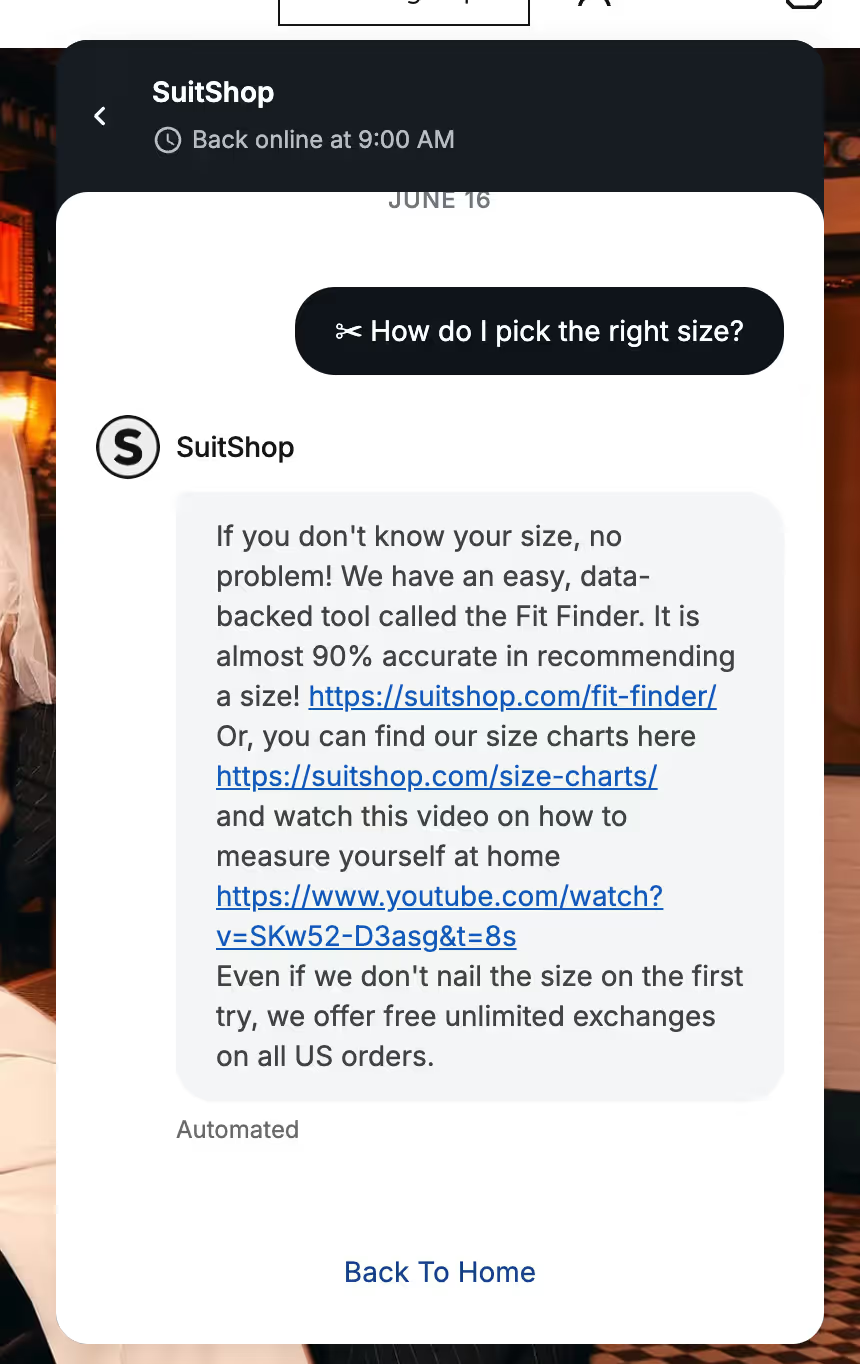
“Once I added specific questions in quotes, it made a huge difference.”
What's next: AI tools that help you scale faster
SuitShop didn’t automate 100% of CX — but that’s not the point. At 30% automation (and growing), Katie gives her team more time to specialize, connect, and handle urgent or emotional conversations with care.
Here’s what Gorgias offers to help as well:
- Optimized intent dashboards: These show the most common topics customers ask about, the AI’s performance on those topics, and how much opportunity there is to increase automation.
- Auto-generated knowledge: Based on your macros, Help Center, and even Shopify data, Gorgias can now draft suggested guidance for your review, making it faster to train your AI Agent without starting from scratch.
- Auto QA: This tool scores every AI (and human) response based on resolution, accuracy, communication, and tone. It gives you full visibility across your team and automations, without needing to review each ticket manually.
Whether you’re just getting started or trying to move beyond basic automation, Katie’s approach proves that coached AI outperforms out-of-the-box tools every time.
Want to coach your AI Agent like SuitShop? Book a demo to see how Gorgias can help you scale smarter.
{{lead-magnet-1}}

How to Drive Growth with an Automated Subscriber Journey
TL;DR:
- Subscribers drive 3x more value than one-time buyers. Subscriptions create ongoing relationships that build loyalty and increase lifetime value.
- Make subscription opt-ins easy and appealing. Use tools like default subscription settings, upsell widgets, and A/B testing to encourage conversions at every step of the journey.
- Retain subscribers by treating key drop-off points as recovery moments. Use win-back campaigns, payment recovery, and personalized support to reduce churn.
- Meet customers where they are with AI-powered tools. Solutions like Gorgias Shopping Assistant and Recharge Concierge SMS provide real-time, contextual support and subscription management.
Vanessa Lopez, VP of Customer Experience at Recharge, recently led a workshop that outlined how brands can transform one-off interactions into rich subscription journeys that increase opt-ins, reduce churn rate, and boost lifetime value (LTV).
Here’s what we learned.
What are the different subscription types?
There are many different ways that you can offer subscriptions. Here’s a rundown of the most common.
Subscribe and save
The most common subscription type is “Subscribe and save.” Instead of making a one-time purchase, customers subscribe to a product and receive it on a different cadence, whether that's weekly, bi-weekly, monthly, or quarterly.
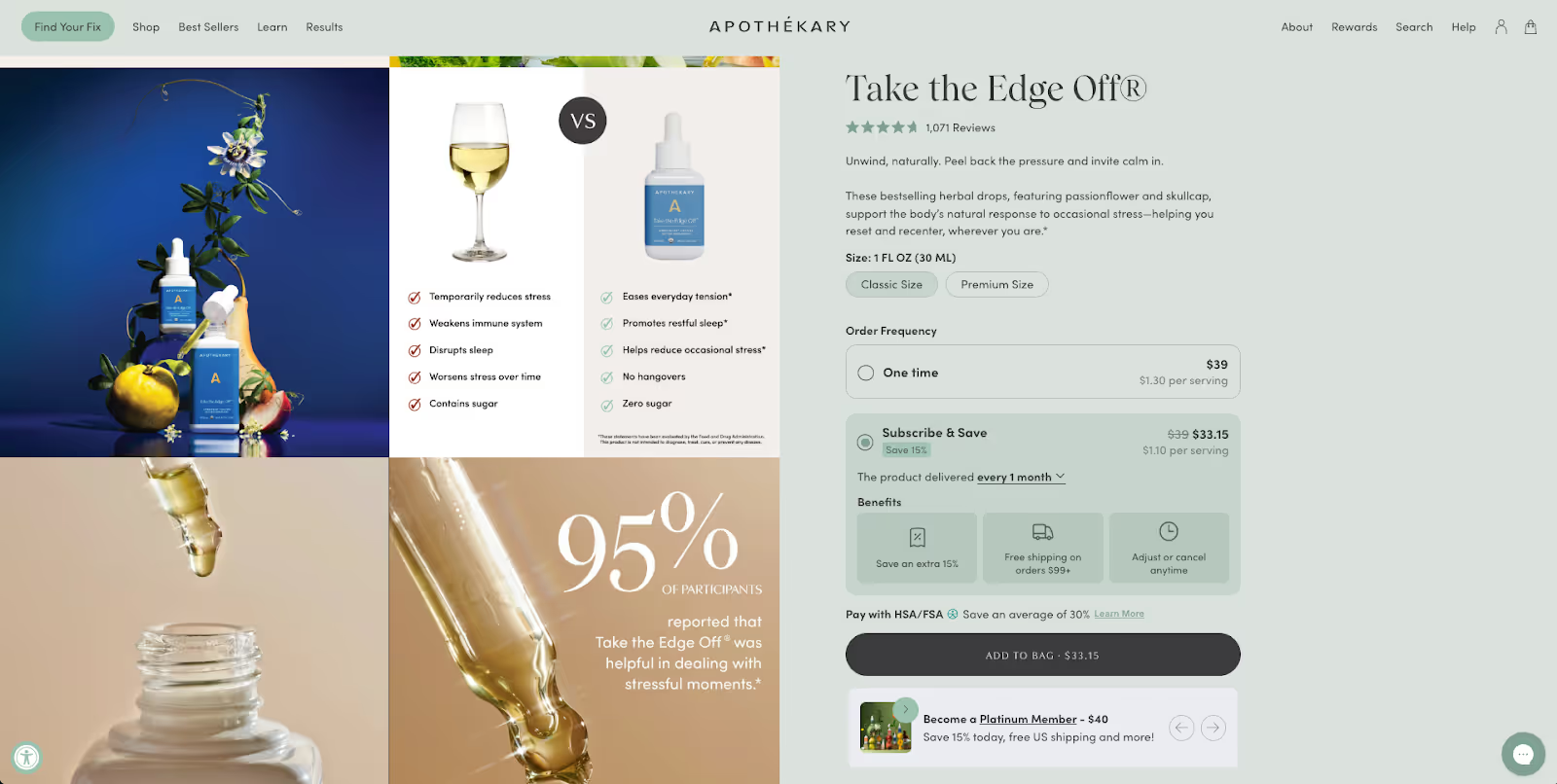
For example, Apothékary offers a Subscribe and Save option for its herbal remedies where shoppers get a discounted rate if they subscribe every one, two, or three months.
Subscription boxes
Subscription boxes ship to customers monthly. Shoppers subscribe over a course of time, like every quarter, six months, or year. For example, CrunchLabs offers a prepaid Build Box option for kids and adults who want to tinker like engineers.
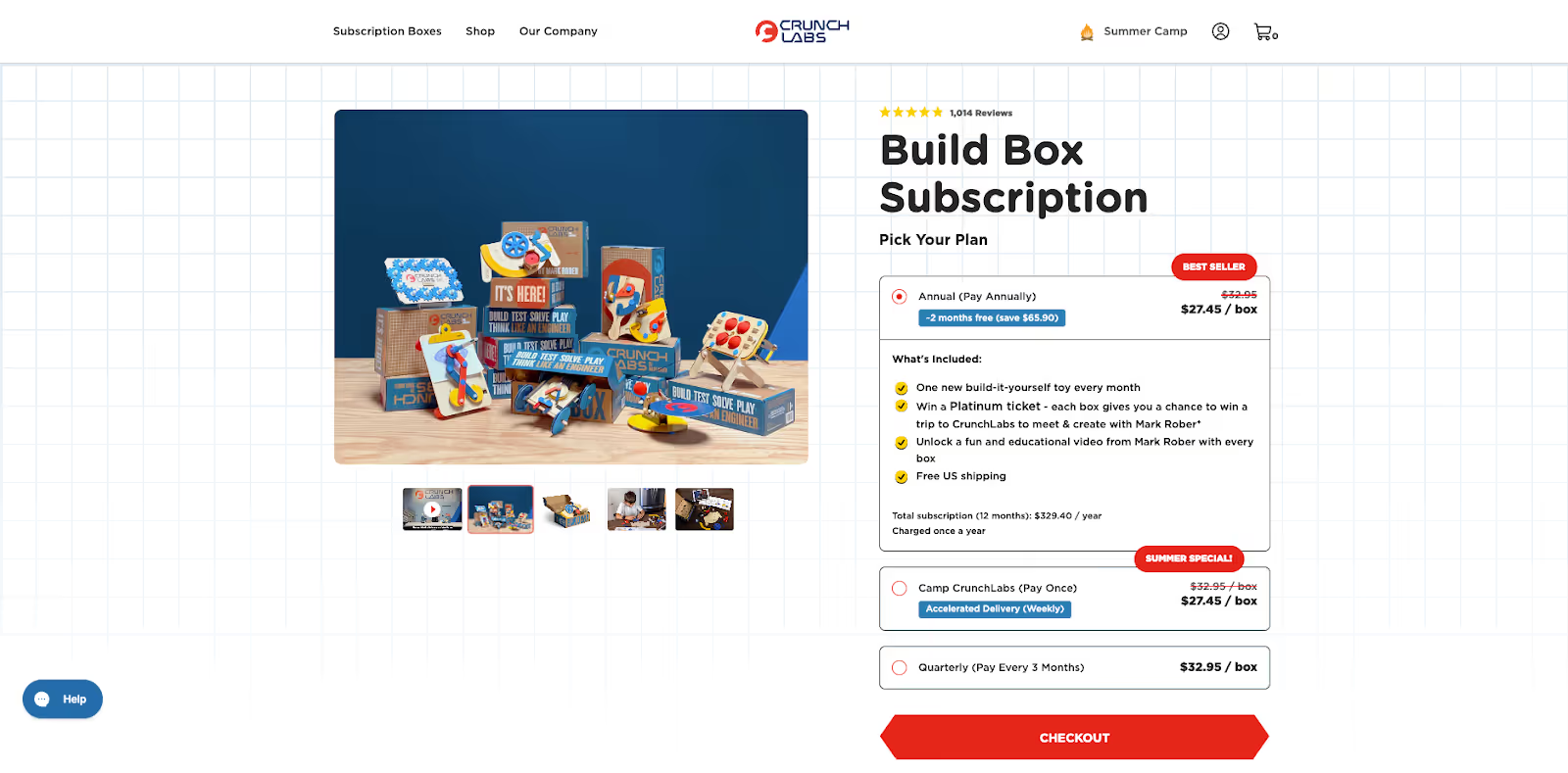
Meal kits
Meal kits are weekly food delivery services that either include pre-packaged ingredients to cook a dish or fully cooked dishes.
Surprise and delight
For brands that are selling higher-cost or unique items, subscriptions to purchase the same product over and over might not be the best way to gain subscribers.
The better option is a curated box, also known as a "subscribe and delight" or “mystery” box. It’s a unique way to cater to customers who prefer trying out different products, rather than receiving the same product on a recurring basis.

For example, premium snack box brand Bokksu specializes in shipping Japanese snacks. Rather than packing the same treats each month, the brand curates different items with every package. This creates both excitement and differentiation each time a customer gets a delivery.
How to drive revenue growth with subscriptions
- Turn interactions into journeys
- Create multiple touchpoints for conversion
- Retain subscribers over time
- Meet customers where they are
- Approach AI as a solution-driver
Subscriptions are the original relationship between a brand and its customer. In fact, subscribers drive three times more value than the one-time buyer. That's because a one-time purchase is really just that—a moment in time—while subscriptions are a journey.
“When you have a customer and they subscribe, you get to see that moment they fell in love with your brand,” says Vanessa. “You get to see when they have those moments where they made you a part of their routine. Every time they engage with you and purchase something new, you learn their rhythms. You learn their preferences. It's impossible to do that with one-time buyers for the most part.”
Subscribers drive three times more value than the one-time buyer, and that's because a one-time purchase is really just that—a moment in time—while subscriptions are a journey.
1) Turn interactions into journeys
Subscribers can only drive growth if you can get those customers to subscribe in the first place. This is what Recharge does: it takes customer interactions and turns them into a customer journey, allowing you to act on those signals in a personal way at scale.
It all starts the moment a shopper browses a product. Each touchpoint is an opportunity to turn that shopper into a subscriber—from the product description page to the subscription widget to checkout.
Vanessa’s tip? Make subscriptions the default option on a product description page. When you present customers with the better and more convenient option, and they see this information at the right time, they're more likely to subscribe.
Put it into practice 💡
Now, it’s time to test. Here's a checklist you can follow to A/B test your subscription journey:
- Test the small details, like button styles, CTA copy, subscribe and save benefits, and their positions on the page.
- Compare different value propositions and discounts.
- Analyze the difference in opt-in and subscriber rates and product performance, and keep iterating.
When customers see the right information at the right time, they're more likely to subscribe. That's because it's the better and the more convenient option.
2) Create multiple touchpoints for conversion
Let's say you have a customer who starts on a product description page. They decide not to subscribe—no worries. You can catch them in the cart.
When they add a product to their cart, you can upsell them with different subscription benefits so they know what they're missing out on. Do it again when they review their cart, and then again when they go to checkout, showing them complementary products that they might be interested in.
And don’t forget to take advantage of that post-purchase "your order is confirmed" high—offer customers cross-sell products, complementary products to their order, or similar items to what they've purchased in the past.
By creating multiple touchpoints for conversion, you’ll increase the possibility that they’ll make a purchase.
Put it into practice 💡
Set up automations in the subscription tool –– like Recharge –– you use. That means adding on upsell and cross-sell tools, and perfecting the times they trigger for customers. Test out different copy and cross-sell/upsell offers to see what resonates the most.
3) Retain subscribers over time
Just as important as acquiring customers is keeping them around.
The Recharge team names three core customer moments that might actually diverge from what brands expect to happen in the customer journey:
- When a payment fails
- When a customer cancels their subscription
- When a customer skips—and keeps on skipping
And while they might seem like hiccups in the process, these moments are actually hero moments. They’re moments that give you the opportunity to actually win those customers back.
Put it into practice 💡
- Prevent cancellations by addressing individual customer concerns at scale with a help desk like Gorgias.
- Set up win-back campaigns. Recharge found that these types of campaigns can convert up to 35% of subscribers by giving them a compelling personalized offer and a straightforward reactivation.
- Recover failed payments to ensure small issues –– like billing and shipping address inconsistencies –– don’t get in the way of your sales.
- Connect all of your customer touchpoints with rewards and referral products.
4) Meet customers where they are
For browsing shoppers, educational and informational resources are the best way to meet their needs, hesitations, and objections.
For regular subscribers, it’s providing them with direct control over their subscription, whenever they want.
The goal is to reach customers where they already are and respond instantly to their needs in a personalized way.

Gorgias’s Shopping Assistant does exactly that—meeting customers where they are by answering customer questions and even initiating conversations based on browsing activity.
This AI sales tool detects a shopper's intent, cart contents, and browsing behavior to initiate conversations, recommend products, and even send discounts as they make a decision.
Modern bidet brand TUSHY saw a 20% increase in chat conversion rate after implementing the tool.
Put it into practice 💡
Decide how you’d like to leverage AI and automation to meet customers where they are. That might be by providing a phone number that customers can interact with via SMS, or implementing a tool like Shopping Assistant to strike up conversational AI chats. Using AI and automation will help you better meet your customers where they are and at scale.
5) Approach AI as a solution-driver
Rather than using AI to come up with problems your brand can solve, Vanessa recommends looking at the challenges your brand has already seen with subscriptions.
The key is to view AI as a tool that drives three core areas:
- Scaling your business without adding headcount
- Reducing churn
- Increasing how much customers spend with you over their lifetime
Vanessa says the most effective strategy starts with leveraging AI-powered tools, such as Recharge’s Concierge SMS.
Typically, SMS tools use template auto responses like, "How do you want to manage your subscription? Type one to cancel, type two to skip." But these aren’t compelling enough for customers to respond. What if they want to do something that doesn't fit in those two options?
Concierge SMS enables brands to build stronger relationships with their customers through conversations powered by pre-trained AI. It personalizes SMS support with customers, so relationships can expand into loyalty.
Put it into practice 💡
Implement an AI-driven subscription management tool that allows customers to interact and ask questions via SMS, rather than only being able to confirm or deny upcoming shipments.
Grow your brand sustainably
Gorgias and Recharge are a powerful combination when it comes to integrating subscription management with top-notch customer support.
With Recharge, efficiently convert one-time buyers into subscribers, retain subscribers through intelligent interventions, and connect every customer touchpoint into one cohesive journey.
With Gorgias, sell more and resolve support inquiries with conversational AI.
{{lead-magnet-1}}

How Do You Build a Support Sales Flywheel? Lessons from 4 Experts
TL;DR:
- Segment customers for personalized support. Use purchase history and behavior data to tailor every interaction, making conversations more relevant and higher-converting.
- Offer onboarding calls for complex products. TUSHY's "Poo-Rus" turned free install calls into a $15 paid service that dramatically boosts customer LTV and retention.
- Pick up the phone strategically. Use voice calls for abandoned carts, stuck tickets, and VIP follow-up.
- Give agents freedom to make judgment calls. Empower your team to bend policies and offer solutions that prioritize retention over rigid rules—confident agents drive more cross-sells.
- Train for helpful selling, not pushy pitches. Use roleplaying to teach agents how to spot buying signals and offer value naturally.
At Gorgias Connect LA 2025, CX leaders from Tommy John, TUSHY, Triple Whale, and Talent Pop shared how support teams solve problems and drive revenue.
This shift, known as the support sales flywheel, doesn’t involve massive overhauls or shiny new tools. Instead, it means doing the small things exceptionally well, like picking up the phone, empowering agents to make judgment calls, and adding a personal touch where others automate.
These brands have shown that when support teams focus on consistency, connection, and conversion, the results compound. Every thoughtful interaction spins the flywheel faster, boosting loyalty, LTV, and revenue.
Ahead, we’re breaking down the most actionable takeaways so your team can start building its own support-led growth engine.
Watch the full panel here:
5 tactics that power the support sales flywheel
From scrappy install calls to AI-powered training, these CX leaders aren’t only talking about driving revenue, they’re doing it. Here’s how they’re turning support into a sales flywheel, and the tactics your team can start testing today.
1. Personalization at scale starts with smart data
“Customer service done right is actually a great source of revenue.” That’s how Tamanna Bawa, Tech Partner Manager at Triple Whale, kicked off the conversation on how data can transform CX from reactive to revenue-driving.
She advises segmenting customers based on purchase history and behavior to deliver more personalized, higher-converting interactions.
In a market where margins are razor-thin and ad costs are high, Tamanna emphasized that “incremental gains from personalization are the difference between companies that are thriving and the ones that are just surviving.”
Steal this strategy
- Segment customers based on behavior and purchase history using your helpdesk, CRM, or analytics tool.
- Give agents access to this data so they can personalize every interaction.
- Use macros that adapt based on customer segments, like VIP status, product interest, or past issues.
- Focus on relevance over volume: one well-timed, tailored message converts better than a generic one.
2. The power of onboarding calls
What do you do when your hero product needs a cultural shift as much as it needs installation instructions? If you’re TUSHY, you send in your “Poop Gurus.”
Ren Fuller-Wasserman, Senior Director of CX at TUSHY, shared how her team launched a scrappy, free CX-led service that has now become a legendary video install program to help customers set up their bidets.
The real value wasn’t just tech support. As Ren put it, “It wasn’t about the actual install process, it was the encouragement they needed to change culture.” These calls sparked deeply personal moments (yes, even with cats and toddlers wandering in) and created the kind of emotional connection customers never forget.
Today, that service has evolved into a $15 paid add-on at checkout, and the customers who use it have significantly boost LTV and retention. It’s a masterclass in turning support moments into revenue through genuine human connection.
Steal this strategy
- Identify a product or feature your customers often hesitate to use, install, or fully understand.
- Offer free, low-lift onboarding calls via Zoom or Google Meet to guide them through setup or usage.
- Track LTV, CSAT, or repeat purchase rates for those who opt in.
- If it drives results, package it as a paid add-on at checkout or use it to surprise and delight key segments.
- Use simple tools like Calendly and Typeform to automate scheduling and reduce lift on your team.
3. When in doubt, pick up the phone
Phone support is back, and it’s becoming one of the most effective ways to turn conversations into conversions.
Ren from TUSHY swears by it. Her team uses customer phone numbers from abandoned carts to reach out directly. “You can send a hundred emails,” she said, “but a voicemail from a real person cuts through the noise.” Even if customers don’t answer, the fact that a brand called is memorable, and often enough to drive them back to checkout.
Max Wallace, the Director of CX Tommy John echoed the value of voice. His team recently implemented Gorgias Voice, using it to track conversion rates by agent. That visibility helps them identify what top performers are doing differently and replicate it across the team. “By the end of a tough call, customers often apologize for how they started. You can’t get that kind of de-escalation over email.”
In a world where inboxes are crowded and chat fatigue is real, a real voice builds real trust and real revenue.
Steal this strategy
- Start small: offer limited phone hours once your chat and email support are dialed in.
- Use phone strategically—for abandoned cart outreach, stuck tickets, or VIP follow-ups.
- Track call outcomes with tools like Gorgias Voice to see which agents are converting.
- Train agents to de-escalate and personalize through roleplaying or AI-based call simulations.
Pro Tip: Don’t rush into phone if your other channels aren’t dialed in. “Master email and chat first. Then, start with limited phone hours. Taste it before scaling it,” said Armani Taheri, the co-founder of TalentPop.
4. Trust your team to use their judgment
For Max at Tommy John, revenue-driving support starts with two things: deep product knowledge and the freedom to bend the rules.
“We have five different fabrics for men’s underwear alone,” Max shared. To help customers choose the right one, agents need firsthand experience. That’s why Tommy John sends new products directly to the support team, so they can offer real, personalized recommendations like “Try Second Skin instead of Cool Cotton.”
But product knowledge is only half the equation. The other half is empowering agents to make judgment calls. Tommy John’s “Best Pair Guarantee” allows customers to try a product and get a refund or replacement if it’s not the right fit.
Agents are trained to prioritize retention, offering replacements instead of refunds, recommending better-suited products, and using their own discretion to keep customers happy.
As Max put it, “We don’t have really strict policies… we want them to use their best judgment.” That confidence translates into smoother resolutions, more cross-sells, and customers who stick around.
Steal this strategy
- Send new or popular products to your CX team so they can speak from firsthand experience.
- Build simple product cheat sheets or comparison guides to help agents make tailored recommendations.
- Give agents clear guidelines—but also the freedom to make judgment calls when it comes to refunds, replacements, or policy exceptions.
- Let your team know it’s okay to “bend the rules” if it means keeping a customer happy.
- Track outcomes like retention and CSAT to show how empowered agents directly impact loyalty and LTV.
5. Training teams to sell without the push
How do you train outsourced agents to drive revenue, without sounding like a sales team? According to Armani Taheri of TalentPop, it starts with confidence and context.
“You have to tailor-fit the training approach to each brand,” he explained. That means grounding agents in product knowledge, tone of voice, and customer journey before they ever interact with a shopper.
One of the most effective tactics is roleplaying. Armani’s team uses both live roleplays and AI-powered chat simulations to prepare agents for real conversations, pre-sales, post-sales, and everything in between. Tools like Replit and Lovable help create lightweight, brand-specific training environments agents can practice in at their own pace.
The goal isn’t to turn CX reps into hard sellers. It’s to give them the confidence and consistency to recognize revenue opportunities, and act on them in a natural, helpful way.
Steal this strategy
- Start with the basics: make sure agents understand your product, tone of voice, and customer journey.
- Roleplay low-pressure scenarios, then layer in more complex ones.
- Try AI-powered training tools like Replit or Lovable to create brand-specific simulations agents can practice anytime.
- Emphasize helpfulness over selling: coach agents to spot buying signals and offer value, not push products.
- Review transcripts together to highlight great conversations and show how small shifts lead to better outcomes.
Tools to power your flywheel
Ready to turn your CX team into a revenue engine? Here are some of the tools mentioned by the panelists that help make it happen:
- Gorgias Voice: Track revenue by agent, spot top performers, and improve conversion rates across the team.
- Flip CX: Automate common phone interactions with AI-powered voice support.
- Kixie: Drop voicemails, integrate with Klaviyo and Shopify, and build smart call queues for abandoned cart outreach.
- Calendly + Typeform: Scrappy, low-lift tools for scheduling paid or free support calls that drive LTV.
Whether you're scaling phone support or experimenting with post-purchase outreach, the right tools make the flywheel spin faster.
Your CX team might be your best-kept sales secret
They’re on the front lines with your most engaged customers, answering questions, easing doubts, and uncovering what really drives purchases. With the right tools and training, they resolve tickets and help close the sale.
With tools like Gorgias Voice, it’s easier than ever to connect the dots between conversations and conversions.
Want to see how your CX team can help drive growth?
Book a demo to see how Gorgias Voice powers sales through support.
{{lead-magnet-1}}

Every Successful Marketing Campaign Starts with a Customer Question
TL;DR:
- Start with your CX team—they know what customers are asking. Their insights reveal what’s confusing, what’s converting, and what’s causing returns before marketing ever gets involved.
- Turn pre-sale questions into better messaging. Use common support queries to improve landing pages, product descriptions, and emails so customers feel confident enough to convert.
- Your best-performing products aren’t always the most hyped. Let real customer comments guide your messaging by identifying what people rave about in chats and reviews.
- Customer confusion and returns usually stem from messaging gaps. Fix product pages, policies, and descriptions to better reflect what people need to know upfront.
Your CX team talks to customers every day. They know what’s confusing, driving purchases, and causing returns, because they hear it firsthand.
But all too often, those insights stay siloed in support tickets and live chat transcripts instead of informing the campaigns that shape the customer journey.
This post is here to change that. We’re breaking down the most valuable questions marketing teams should be asking their CX counterparts. When marketing and CX work together, you get more relevant messaging, smarter product positioning, and campaigns that convert.
Whether you’re planning a big seasonal push or just want to improve product education, this is where to start.
{{lead-magnet-1}}
1. What do customers ask about before buying?
Your CX team knows what makes shoppers hesitate. They’re the ones fielding questions like: Does this come in a larger size? Is it final sale? Will it arrive in time?
Beyond being pre-sale inquiries, they’re signals. They reveal what your customers care about most, and where your messaging may be falling short. When marketing teams tune into this, they can proactively address objections in landing pages, product detail pages (PDPs), emails, and top-of-funnel content.

At luxury jewelry store Jaxxon, Director of Customer Experience Caela Castillo saw firsthand how important it is to address these questions early.
“Chat used to be a support tool for repetitive questions and problem-solving, but now AI Agent takes care of that for us,” she said. Once those friction points were handled upfront, the CX team could focus on more meaningful conversations, and conversions improved.
And when AI recommended the wrong products? Conversions dropped. It was a clear signal that relevance matters, especially before the sale.
Ask your CX team:
“What do customers most often need to know before they buy, and how can we answer that earlier in the journey?”
2. What product do customers rave about—and why?
Your best-selling product isn’t always your hero product. Sometimes, it’s that under-the-radar item that customers can’t stop talking about. The one that shows up again and again in reviews, chats, and post-purchase surveys.
The insight is gold for marketers. The key is to find out why people love it. Is it the fit? The feel? The results?
At online fashion brand, Princess Polly, Alexandria shared that her team expected Gen Z shoppers to lean on AI for recs, but what really influenced them was customer feedback. Reviews, not bots, built trust. That’s why campaigns built around real customer language and experiences often outperform the most polished product copy.
Shopping Assistant can turn those rave reviews into real-time action. It highlights top products using your Shopify product catalog to make personalized recommendations, proactively assists shoppers by using behavior signals, and even offers tailored discounts when they’re ready to convert. That means less guesswork, greater relevance, and an easier path to purchase.

Ask your CX team:
“Which product do customers rave about most, and what exactly are they saying?”
3. What product causes the most complaints?
When customers are frustrated, it’s easy to blame the product. But in many cases, the issue isn’t quality, it’s communication.
At Shinesty, a men’s underwear brand, Molly Kerrigan, Senior Director of Retention, observed that high return rates often stemmed from unmet customer expectations.
She noted the importance of maintaining clear and consistent communication as the company grows, “We get a lot of praise from our customers, and they talk highly of our CX team after 1:1 interactions. We can’t lose that as we scale.”
Molly notes that using Gorgias AI Agent enables Shinesty’s customers to receive quick answers, freeing her team's time for more complex or sensitive issues.
Similarly, Princess Polly saw that delivering a standout customer experience meant being fast, consistent, and helpful at every stage. After switching to Gorgias, their support performance improved dramatically:
- 80% decrease in resolution time
- 95% decrease in first response time
- 40% increase in efficiency
Before changing the product, try updating the messaging. Use insights from CX to rewrite descriptions, add size guides, include user-generated content, or even build a quick-fit quiz. Small tweaks help set clearer expectations and reduce unnecessary returns.
Ask your CX team:
“Which products are driving the most complaints, and what do customers wish they knew before buying?”
4. What confuses customers the most?
Confusion is a conversion killer. If a customer isn’t sure about how something works, what’s included, or whether it’s right for them, they’re more likely to bounce.
That’s why it pays to ask your CX team where customers get stuck. Is it a product feature that needs more context? A vague store policy? A missing detail on a bundle?
The good news is that most confusion is fixable. Start with the following steps:
- Simplify your product pages
- Add quick-hit FAQs to your emails
- Use plain language and real examples
If you’re using Shopping Assistant, you can go even further. It can detect when shoppers are hesitant and provides real-time nudges. Like an assistant who knows all your needs, Shopping Assistant automatically surfaces the questions customers are likely to ask when evaluating a product, so they’re equipped with the clarity they need to proceed to checkout.

TUSHY, a modern bidet brand, faced similar challenges. As bidets aren't mainstream in North America, shoppers often had concerns about product compatibility and installation. They’d ask questions like:
- Will a bidet fit my toilet?
- Is installation complicated?
- Which bidet is right for me?
Without immediate answers, many potential buyers would abandon their purchase. To address this, TUSHY implemented Shopping Assistant, providing instant support. Taking this approach resulted in an 81% higher chat conversion rate compared to human agents and a 13x return on investment.
“The Shopping Assistant has been a game-changer for our team, especially with the launch of our latest bidet models. Expanding our product catalog has given customers more choices than ever, which can overwhelm first-time buyers. Now, they’re increasingly looking to us for guidance on finding the right fit for their home and personal hygiene needs,” said Ren Fuller-Wasserman, Sr. Director of Customer Experience at TUSHY.
Ask your CX team:
“Where do customers get confused most often—and how can we clear that up sooner?”
5. Which products are frequently bought together?
Your CX team picks up on patterns that analytics sometimes miss. They hear which items customers ask about in the same chat, which products get added to carts together, and which pairings people reorder time and time again.
That intel is a goldmine for bundling and upselling. It helps you build smarter campaigns that feel relevant and drive real value.
Zoe Kahn, owner of Inevitable Agency and former VP of Retention and CX at Audien Hearing, emphasizes the importance of using AI to enhance customer interactions.
“A lot of that revenue was potentially missed revenue because these were customers sitting on the site, asking questions about the products, and wanting an answer now so they could purchase…Now, AI can answer those questions immediately and convert those customers.”
With Shopping Assistant, you can act on these insights in real time. It will surface personalized product pairings, bundle suggestions, or accessories based on customer behavior. All before they hit the checkout page.

6. Which products lead to the most returns, and why?
Returns cut into your margins and chip away at trust. Most of the time, they’re not caused by poor-quality products. They happen because expectations weren’t met.
Your CX team already knows which items come back the most and why. Maybe the color doesn’t match the photos. Perhaps the fit runs small, or the product description left out a crucial detail.
Instead of pushing the product harder, reframe how you present it. Add real customer photos. Include fit notes or a sizing chart. Call out anything that might surprise the customer post-purchase. A little clarity upfront goes a long way in reducing returns and boosting retention.
At Pepper, an intimates brand specializing in bras for small-chested bodies, they recognized the importance of pre-sale education. When customers have sizing questions, their AI Agent, Penelope, can provide immediate assistance.
“Penelope takes the information we give her and responds better than a Macro. She tailors it so that it sounds like a natural conversation between two people,” said Gabrielle McWhirter, CX Operations Lead at Pepper.
By proactively providing instant support, Pepper improved customer satisfaction and saw an 18% uplift in average order value.
Ask your CX team:
“Which products get returned the most—and what could we do upfront to change that?”
CX + marketing = smarter campaigns, better results
Before you launch your next campaign, start with a quick sync with your CX lead. They already know what your customers need to hear. You just have to ask.
From fixing messaging gaps to surfacing the right products at the right time, these insights help you connect with customers in personal, timely, and relevant ways.
Tools like Shopping Assistant make it easier than ever to act on this data in real time. You can turn CX knowledge into dynamic recommendations, personalized nudges, and smarter discounts.
Ready to see how you can improve your online shopping experience? Book a demo to see how Gorgias Shopping Assistant engages customers in real-time.

How to Use CX Data to Improve Marketing, Messaging & Conversions
TL;DR:
- Your support inbox is full of marketing gold. CX insights can sharpen messaging and inspire high-impact campaigns.
- Ticket data unlocks smarter segmentation. Use support interactions to build more relevant, behavior-based audiences.
- Chat campaigns work better with CX insights. Tackle objections in real time and lift conversions with proactive messages.
- Use objection data to reduce drop-offs. Identify common blockers and address them in product pages, ads, and chat prompts.
- Help Center stats guide better content. Turn top-searched questions into FAQs, landing pages, and ad copy.
Today’s best marketing starts with your customers.
According to Forrester’s 2024 research, “Customer-obsessed organizations reported 41% faster revenue growth, 49% faster profit growth, and 51% better customer retention than those at non-customer-obsessed organizations.”
Support teams interact with hundreds or thousands of customers every week, collecting valuable insights in the process. This voice of the customer (VOC) data is a goldmine for marketers, but it too often stays siloed among CX teams.
Ahead, we’ll break down how ecommerce brands can tap into CX insights to drive better marketing.
5 ways to use CX data to improve marketing
CX can play a crucial role in driving growth, but many brands aren’t leveraging it for marketing insights yet.
When connected to marketing, CX becomes a proactive engine that fuels better segmentation, sharper messaging, smarter campaigns, and more personalized content.
Support functions collect objections, complaints, compliments, and pre-purchase questions. When you capture and apply those insights, your marketing can target the precise roadblocks—and key sales differentiators—customers care about.
Here’s how to turn CX insights into a high-impact marketing strategy, with real examples from brands using Gorgias.
- Leverage ticket insights to improve messaging
- Segment customers based on support interactions
- Launch more targeted chat campaigns
- Reduce drop-offs and abandoned carts
- Monitor Help Center and Dashboard stats to craft smarter content
1) Leverage ticket insights to improve messaging
When you want to sharpen your brand messaging, there’s no better place to look than your support inbox. Your support inbox is a rich resource full of information specific to your brand and your customers.
Tools like Gorgias Ticket Insights help surface recurring themes, top questions, and friction points across all conversations. By analyzing these patterns, marketers can identify the exact words customers use to describe problems, questions, or product feedback and then reflect that language across ads, landing pages, and emails.
How to implement
Spikes in tickets around specific topics (sizing, shipping timelines, and materials, for example) are insights marketers can use to update and improve corresponding content.
This can increase confidence and conversion on key pages.
By incorporating the same terminology and phrasing customers use in support conversations, brands can also increase resonance across ads, emails, and social media. Messaging that mirrors the customer’s language builds trust and helps audiences feel understood.
Ask your CX team 💬 What product issues or themes have emerged this quarter?

For example, cordless heating cushion brand Stoov® used Ticket Fields in Gorgias to understand and resolve a ticket spike. By figuring out that some customers were dissatisfied with the battery life of its core product offering, the team was able to add an optional upsell. For €20, shoppers now have the option to purchase a larger battery.
The results were meaningful: the brand saw 50% of customers opt for this battery, resulting in a 10% increase in average order value (AOV). And while the team saw a significant increase in revenue, they saw no increase in support ticket volume.
2) Segment customers based on support interactions
Most marketers rely on transactional data—like past purchases or time since last order—to build audience segments. But support data reveals a whole new layer of context: behavior, concerns, sentiment, and urgency.
Tools like Gorgias’s Ticket Insights and Ticket Fields allow CX teams to customize different properties attached to tickets. Agents can fill these out to capture data more accurately.
Here’s how these types of tools work: tickets come with a mandatory field for return reasons, product feedback, contact reason, etc. Before the agent closes the ticket, they use a dropdown menu to fill out the ticket field.
How to implement
Studying support interactions helps answer key questions around why customers are getting in touch. This data can provide marketing teams with a way to build smarter segments for campaigns or personalized journeys.
For example, if one product is getting a large amount of inquiries, marketing teams could segment customers interested in those products and launch pre-sales education campaigns.
Fashion brand Psycho Bunny switched from Zendesk to Gorgias to improve access to reporting tools that surfaced customer patterns and support trends.
“By cross-referencing our Gorgias data with insights around basket size, product performance, and store performance, we can inform broader business decisions. For example, we can see if a certain store location generated more tickets or how many incoming queries are about a certain product,” says Jean-Aymeri de Magistris, VP IT, Data & Analytics, and PMO at Psycho Bunny.
By integrating insights like these with marketing workflows, teams can build more relevant segments that improve retention and engagement.
Ask your CX team 💬 Which customer segments are most likely to churn or repurchase?
3) Launch more targeted chat campaigns
Chat campaigns are proactive messages that trigger based on real-time behavior and context. You can use CX trends to design campaigns that directly address common objections, answer FAQs, or deliver tailored offers.
How to implement
Start by reviewing your most common pre-purchase questions with your CX team. Then, create chat prompts that address those concerns exactly where they arise. For example, a sizing guide prompt on product pages or a shipping FAQ in the cart.
Make sure your message feels helpful and not overly salesy. Conversational AI assistants like AI Agent can also tailor responses in real-time, helping customers get what they need without leaving the page.

Pepper, a size-inclusive bra brand, put this into practice by combining their AI Agent (named Penelope) with targeted chat campaigns to guide shoppers through one of their most common friction points: sizing. Thanks to insights from their support team, Pepper created messaging that helped customers find the right fit instantly. The result was an 18% uplift in average order value.
“With AI Agent, we’re not just putting information in our customers’ hands; we’re putting bras in their hands. With Penelope on board, we’re turning customer support from a cost center to a revenue generator,” says Gabrielle McWhirter, CX Operations Lead at Pepper.
Ask your CX team 💬 How are customers reacting to recent promotions or launches?
4) Reduce drop-offs and abandoned carts
When shoppers hesitate at checkout, it’s often because they don’t have the information they need.
Tapping into support conversations allows CX teams to identify common objections. They can then share those insights with marketing to refine product messaging, improve product pages, ads, and marketing campaigns.
How to implement
Use customer service data to identify the top three objections customers have before converting. These might be concerns about sizing, compatibility, delivery time, or product setup. Then, pair that knowledge with a proactive AI sales tool like Shopping Assistant to offer timely answers that move shoppers closer to purchase.
For example, TUSHY, a modern bidet company, found that many prospective customers were hesitant because they weren’t sure how difficult the installation would be. By using a real-time shopping assistant to address these concerns directly on-site, TUSHY was able to guide shoppers past uncertainty.

Ask your CX team 💬 What are the top three reasons customers contact us before they buy?
5) Monitor Help Center and Dashboard stats to craft smarter content
If you want to know what content your customers actually need, your Help Center holds the answers. Real customer questions are found right in Help Center search queries and article analytics.
By tracking which articles are most viewed, most searched, and most frequently updated, marketers can spot common knowledge gaps and fill them with high-value content.
How to implement
Start by reviewing your Help Center Statistics to see which articles are performing well, which ones are underutilized, and what terms customers are searching for.
If an article about “returns policy” is getting a spike in views, that’s your cue to simplify the policy or preempt questions with a dedicated email campaign. Marketing teams could also use this insight to build FAQ-rich landing pages, preempt questions in email flows, or even turn top-performing help content into organic blog posts or performance ad copy.

You can also use Gorgias's Dashboard to spot emerging trends across all your channels. This custom reporting feature lets you choose from various charts that reveal high-level patterns—like the most common contact reasons or sudden spikes in ticket volume—giving marketers early insight into shifting customer sentiment and trending topics across social platforms.
Ask your CX team 💬 Which articles in our Help Center are most searched right now?
Find alignment between CX and marketing teams
When support and marketing teams collaborate, you unlock a cycle of continuous improvement. CX teams surface the insights, marketing turns them into strategy, and both sides drive measurable results.
Here’s how to make it work:
- Set up recurring syncs between CX and marketing teams to review insights from customer service reports.
- Involve support in campaign planning to consider what customer objections might come up.
- Encourage CX to tag tickets based on themes or behavior that marketing can act on.
Unlock revenue by listening to your customers
We need to reframe CX as a proactive function that drives revenue.
Support teams already have the answers marketers are searching for. You just need the tools to tap into them. Gorgias makes that easy, with flexible reporting features, powerful AI, automated tagging, and integrations that bridge the gap between CX and marketing.
Want to connect your support data to better marketing?
Explore Gorgias’s analytics tools or book a demo to speak to a product expert about how to integrate your support strategy with marketing.
{{lead-magnet-1}}

The Hidden Cost of Not Adopting AI in Ecommerce
TL;DR:
- Ecommerce brands not using AI are falling behind, as 77.2% already use it daily to boost efficiency and revenue.
- AI saves time and cuts costs, like Trove Brands saving $23K/month and reducing cancellations by 70%.
- Customers want speed and privacy—AI provides fast, judgment-free answers in sensitive categories.
- AI empowers support teams by handling routine tasks so agents can focus on high-value interactions.
Doing nothing when there’s rapid change happening in an industry is risky business.
Right now, according to our latest report, 2025 Ecommerce Trends, 77.2% of ecommerce professionals are already using AI in their day-to-day work. What happens if you’re part of the 22.8% that isn’t?
Inaction is action—one that’s a quiet drain on revenue, resources, and reputation.
Every minute spent on manual work is a minute your competitors are focusing on higher-value customer interactions, improving CX, testing offers, and scaling campaigns.
And the cost of falling behind is compounding fast. Here’s what you’re losing when you pass on AI.
Time lost = money lost
As support volume grows, so does the cost of inefficiency.
Nearly 80% of CX professionals say AI saves them time. In fact, 83.9% of support leaders using AI in Gorgias say it has made their teams more efficient.
Trove Brands experienced this firsthand:
- They reduced missed cancellations by 70%
- And saved $23,000/month in labor costs by automating repetitive support tasks
If AI can handle 70% of your support tickets, your team finally has the time—and headspace—to focus on the 30% that actually builds trust, drives repeat revenue, and improves the customer experience.
Trust when customers need it most
Hot take: AI isn’t impersonal. Not using it is.
In 2024, nearly one-third of CX leaders worried AI would make interactions feel less human. A year later, that number dropped by half.
Why? Brands started to see that AI wasn’t hurting the customer experience, it was removing friction from it.
For sensitive or personal products—think wellness supplements, intimate gifts, or anything a shopper might feel awkward asking about—AI creates space for honesty without judgment. And that can change the outcome entirely.
“Too often, a great interaction is diminished when a customer feels reduced to just another transaction,” said Ren Fuller-Wasserman, Senior Director of Customer Experience at TUSHY. “With AI, we let the tech handle the selling—unabashedly, if needed—so our future customers can ask anything, even the questions they might be too shy to bring up with a human. In the end, everyone wins.”
It’s a powerful point, especially for brands where discretion matters. AI removes that barrier.
You're losing trust if your support experience still makes customers hesitate. For many, that means being able to get an answer without needing to explain themselves first.
Revenue hiding behind unanswered questions
Every unanswered pre-sale question or missed upsell is revenue slipping through your fingers.
Product recommendations alone have the potential to increase revenue by up to 300%, boost conversion rates by 150%, and drive 50% higher AOV. But those results don’t come from hoping customers find what they need. They come from proactively guiding them.
That’s where AI comes in.
With Gorgias AI Agent and automation features, for example, Kirby Allison
- Increased conversions by 23%
- Grew sales from support by 46% in just two months
“Our favorite features are definitely Flows and Article Recommendations. They drive so much automation for us. Shoppers get answers to their questions by themselves—what’s the right size hanger, where is my order, what shoe polish would you recommend, etc,” said Addison Debter, Head of Customer Service.

Flows let Kirby Allison surface up to six commonly asked questions directly in the chat widget. When clicked, each one opens a relevant help article—no agent needed.

Auto responses also allowed the team to handle common inquiries like sizing, shipping, and order tracking before a human ever steps in.

If your support team isn’t set up to handle pre-sale conversations at scale, the cost isn’t just in time. It’s in all the revenue you never realize you’re missing.
A CX team stretched thin
It might sound counterintuitive, but AI gives your team more space to be human.
The myth that AI replaces agents is still floating around in some circles, but the reality inside fast-growing ecommerce teams looks different.
In fact, AI frees up time for your team to focus on what they do best: solving complex problems, building relationships, and creating moments that actually drive loyalty.
SuitShop is a perfect example of this in action. When the team adopted AI Agent, they paired automation with intentional escalation:
“We’re helping customers feel confident during some of the most important moments in their lives—weddings, proms, job interviews, and everything in between. Naturally, my biggest concern with introducing AI was: ‘Will customers feel like they’re getting the same level of care from AI?’ But learning that AI Agent would pull knowledge from our Help Center articles and Macros, which are already written in our brand voice, made me feel more confident,” said Katy Eriks, Director of Customer Experience.
AI was able to handle common pre-sale questions like shipping timelines and product availability, while human agents stepped in for customizations, wedding-specific questions, and tailored styling support.
The goal wasn’t to remove the human element. It was to give their agents the time and context to show up more meaningfully.
The longer you wait, the harder it is to catch up
In just one year, AI adoption among Gorgias users jumped from 69.2% in 2024 to 77.2% in 2025.
Excitement is rising, too: 55.3% of ecommerce professionals now rate their interest in AI as 8–10 out of 10, up from 45.6% the year prior.
AI is no longer in its experimental phase. It’s the standard, baked into everyday workflows across ecommerce.
If you’re still on the sidelines, 2026 is going to feel like a catch-up game.
The good news? You don’t have to overhaul everything to get started.
So while we’re on the topic of speed, let’s walk through how to start implementing AI for your brand.
How to get started with AI
You don’t need to automate everything on day one. The best CX teams start small, pick the right entry points, and give AI the same level of care you’d give a new team member. Here’s how to roll out AI in a way that actually works:
1. Vet your options thoughtfully
When searching for a new AI tool to help you manage CX, look for one that:
- Offers strong tone-of-voice control so your AI doesn’t sound like a chatbot from 2012
- Delivers consistently accurate responses, even as inputs and workflows evolve
- Provides real post-sale support to help your team troubleshoot, train, and scale usage
Price matters, but it shouldn’t be your only filter.
Also, AI should make your team feel more capable. If it feels like a bolt-on or requires constant developer help, it’s going to create friction, not solve it.
2. Make someone own it
The most successful AI implementations all have one thing in common: someone owns it.
“One of our CX Managers spent 30–40 hours a week building and refining AI. That ownership was critical,” said Sarah Azzaoui, VP of Customer Experience at Clove, when she was explaining how her team first got started with AI.
What many people don’t realize is that AI isn’t going to be perfect out of the gate. AI takes real time and intention to build out. Assigning a clear point person—or better, a small squad—ensures someone is tracking performance, making optimizations, and flagging edge cases.
3. Involve your CX team from the start
No one knows your customer conversations better than your support team. They see the full range of questions, tone, friction points, and emotional nuance every day.
Bringing them into the AI rollout early helps you:
- Identify which questions are repetitive and low-stakes
- Flag which issues should always be handled by a human
- Set realistic expectations across the org about what AI should handle vs. what it could handle
This step also builds trust. If your agents feel like AI is something being done with them instead of to them, adoption is smoother and the outcomes are better.
4. Start small with the right topics
One of the biggest mistakes brands make with AI is trying to do too much, too soon. AI rollout should feel like a phased launch, not a switch flip.
Start in a test environment if your platform allows for it. Roll out automation in stages—by topic, channel, or ticket type—and QA every step of the way.
We suggest beginning with high-volume, low-complexity tickets like:
- “Where’s my order?”
- Subscription pauses or cancellations
- Returns and exchanges
- Store policies and FAQs
Platforms like Gorgias offer tools like Auto QA that track whether AI responses hit the right tone, offer accurate answers, and resolve issues effectively. Use those tools to catch gaps early and monitor performance over time.
That slow, deliberate rollout pays off in performance. At Psycho Bunny, AI Agent now automates 30% of customer tickets, with custom messaging that reflects their brand tone and processes.
Once you’re ready to scale, you’ll feel more confident that the simple queries are handled correctly while you start to train the AI on more nuanced questions.
For example, Gorgias’s Guidance feature gives AI access to non-public SOPs so it knows how to respond or when to escalate.
“The Guidance feature is so important,” said Tosha Moyer, Senior Customer Experience Manager at Psycho Bunny. “We have a lot of processes that we definitely don’t want described in a customer-facing article, but we want AI Agent to be able to access that information and manage tickets accordingly.”
5. Prep your knowledge base
Even the best AI platform can’t succeed without solid inputs.
Before you roll out, take a hard look at your help docs and macros:
- Are they accurate?
- Are they clear and consistent in tone?
- Are they tagged so AI can understand when to use them?
Think of this step as training your AI. The stronger your internal content library, the more helpful and brand-aligned your AI will be across every channel.
6. Communicate with customers
Whether you disclose AI usage is up to you, but be intentional.
Some brands choose anonymity for a more seamless experience. Others find that transparency builds trust, especially when something goes wrong.
What matters most is that your approach aligns with your brand tone and customer expectations—and that clear escalation paths are in place if a conversation needs a human.
Research shows that 85% of consumers want companies to share their AI assurance practices before rolling out AI-powered experiences. Customers are open to AI. But they expect clarity when it counts.
7. Scale the program over time
Once you’ve built the foundation, scaling AI across your CX org becomes a lot easier.
“We started with cancellations. Now we’re rolling out warranty claims, retention campaigns, and more,” said the team at Trove Brands.
After proving value with one or two ticket types, look for opportunities to expand:
- Pre-purchase product recommendations
- Exit-intent offers via chat
- Predictive personalization
- Multichannel automation across email, SMS, and live chat
The goal is to implement smarter automation that makes your team more effective and your customers more supported.
The future is human + AI
The best CX teams aren’t choosing between AI and human agents. They’re choosing both and building stronger systems because of it.
“It’s not human agents vs. AI,” said the team at Clove. “Our team helped shape the AI strategy—and that changed everything.”
But ignoring AI? That comes at a cost. And it’s not just inefficiency. It’s:
- Missed sales from unanswered questions
- Slower support that erodes customer trust
- Burnt-out teams stuck in reactive mode
- Lower CSAT from inconsistent experiences
- And eventually, falling behind as the rest of the market moves forward
It’s time to build it into your workflows. Not just as a helper, but as a core part of your team.
Start using Gorgias AI Agent to reduce ticket load, recapture revenue, and deliver the kind of support that actually feels personal.
{{lead-magnet-1}}

Stop Resolving These 7 Tickets Manually (Use AI Agent Actions Instead)
TL;DR:
- Actions are tasks automatically performed by AI Agent for customers. From address changes and subscription pauses to order cancellations, Actions can fulfill requests for your customers, even when your human agents are offline.
- Actions connect directly to your ecommerce apps. Currently, Actions have native integrations with Shopify, ShipMonk, ShipHero, ShipStation, Stay AI, Recharge, Loop, Subscriptions by Loop, Skio, Seal Subscriptions, and Wonderment.
- Use pre-built Actions or build your own. There are 12 Action templates available, or you can build Actions using custom HTTP requests.
- Watch out for setup snags. Conflicting Guidance, multiple matching Actions, older orders, or broken logic can block an Action from executing.
Automated responses don’t actually resolve anything. In reality, they increase customer wait time.
What a customer really wants is immediate resolution, whether they’re looking to cancel an order, change a shipping address, or pause a subscription.
So, how do you go beyond automated text responses? AI Agent Actions.
Below, we’ll go over the 7 most common customer service requests you can resolve with AI Agent Actions, so your team gets time back to strengthen customer relationships, increase revenue, and improve your CX strategy.
{{lead-magnet-1}}
What are AI Agent Actions?
AI Agent Actions are tasks AI Agent can complete for your customers, such as canceling an order or updating a shipping address.
Instead of handing it off to a human agent, AI Agent resolves the ticket by connecting to your ecommerce apps and performing the action on its own.
You get maximum control over when and how Actions are executed. Before performing the Action, AI Agent asks customers for confirmation, respecting your processes and maintaining a high level of customer service. Once an Action has been taken, you can even share feedback with your AI Agent to reinforce its behavior or finetune it further.

Pro Tip: Unlike Guidance, which tells AI Agent how to respond in a conversation, Actions determine what happens. It’s the difference between saying “I’ll refund your order” and doing it.
Related: How AI Agent works & gathers data
Top 7 customer requests you should be automating with AI Agent Actions
Ready to resolve requests in seconds? Activate these pre-built Actions in Gorgias to keep your team efficient and your customers happy.

1. Customer wants to update their shipping address
Action to use: Update shipping address
Supported apps: Shopify, ShipMonk, ShipHero, ShipStation
Incorrect shipping addresses lead to costly re-shipments, delays, and even refunds. Catch errors early to keep customers satisfied and excited about their order.

Why do you need this Action?
The reality is your agents aren’t available 24/7. Unless you hire a team to cover night and weekend shifts (which is unlikely), requests will be missed. AI Agent fills in that gap, handling time-sensitive issues when your team is off the clock. Missing them isn’t just about poor customer experience—it can also lead to extra costs, like reshipping orders.
2. Customer wants to cancel an order
Action to use: Cancel order
Supported apps: Shopify, ShipMonk, ShipHero, ShipStation
Perhaps a customer ordered the wrong item, chose the wrong size, used the wrong card, or simply changed their mind. Allow them to quickly cancel their order and receive a refund in one go.

“Actions responds to tickets within about 30 seconds and is available 24/7. Regardless of when a customer places their order, the likelihood of quickly catching and canceling the order has increased by 70% since we started using Actions. It’s an exceptional result."
—Jon Clare, VP of Customer Service at Trove Brands
3. Customer wants to replace/remove an item in their order
Actions to use:
- Replace item, or
- Remove item
Supported app: Shopify
It happens—shoppers order the wrong size or color and want to change their order immediately. Regardless of the reason, make their new decision easy to implement. Quick, accessible order updates prevent returns, lost revenue, and, most importantly, customer disappointment.
Here’s what the replace order item setup looks like in Gorgias:

Pro Tip: If you have unique workflows, you can create advanced, multi-step Actions and connect to your tools beyond our default integrations. This option requires some tech know-how (like custom HTTP requests), so feel free to bring in your developers for assistance.
4. Customer wants to skip or pause a shipment
Actions to use:
- Skip next subscription shipment, or
- Pause subscription
Supported apps: Stay AI, Recharge, Subscriptions by Loop, Skio, Seal Subscriptions
Subscriptions shouldn’t be all or nothing. Let customers skip a shipment or pause their subscription, so they can come back when they’re ready. Giving them full control lets them manage their subscription on their own terms, reducing churn rate in the process.
Here’s how AI Agent handles a skip shipment request:

5. Customer lost or damaged their order in transit
Action to use: Reship order for free
Supported apps: Shopify, ShipMonk
No customer expects a lost or damaged order. Let customers know that you have their backs by reshipping a new order free of charge. Fast resolutions during unexpected events demonstrate your commitment to customer satisfaction.
“An instant response builds confidence. We live in a world with short attention spans, so customers appreciate how quickly we can respond to their inquiries. Customers aren’t worrying unnecessarily for longer than they have to for an address change or order cancellation.”
—Mia Chapa, Sr. Director of Customer Experience at Glamnetic
6. Customer wants to know their return shipping status
Action to use: Send return shipping status
Supported app: Loop
Customers want to know that their return package is on its way to you, so they can redeem their refund. Easily send them a shipment tracking link to give them that peace of mind.
7. Customer wants to know about order status
Action to use: Get order info
Supported apps: Shopify, ShipHero, ShipMonk, ShipStation, ShipBob, Wonderment
Based on Gorgias data, order status ranks among customers' top 10 questions for support teams. Reassure your customers with quick updates on their orders, including product details, shipping progress, expected delivery date, and other helpful information.
What to know before turning on Actions
Here are a few helpful setup tips to make sure Actions run without a hitch:
- Guidance can override Actions. If conflicting Guidance exists, it may prevent an Action from triggering, even when all conditions are met. Review your Guidance to avoid overlaps, or write your logic into the Action description instead.
- Any Action that changes data requires shopper confirmation. Actions like canceling orders, updating addresses, or canceling subscriptions mean AI Agent will always ask the shopper to confirm before making a change.
- Currently, only one Action can run per ticket. If multiple Actions qualify, none will run, and the ticket will be handed off. Use conditions carefully to ensure only one Action matches per use case.
- AI Agent can only access the shopper’s last 10 orders. If the customer references an older order, the Action won’t trigger and the ticket will be handed over for manual handling.
AI Agent Actions speak louder than words
If you want…
- Fewer repetitive tickets
- Faster customer support
- Happier customers who get what they need instantly
- More time for your team to strategize
- Lower costs and higher efficiency
AI Agent Actions can get you there.
You’ve now seen how Actions can resolve tickets in a snap—no unnecessary handoffs, canned responses, or long response times.
Book a demo to see AI Agent Actions work in real time and start automating what you shouldn’t be doing manually anymore.
{{lead-magnet-2}}

How to Write Guidance with the “When, If, Then” Framework
TL;DR:
- AI Agent is only as good as the instructions you give it. Clear Guidance enables it to perform like your best support teammate.
- The “When, If, Then” framework makes writing Guidance easy and repeatable. Start with the scenario (when), define the conditions (if), and list specific actions (then) to create structured Guidance.
- Use Guidance to handle frequently asked questions, like returns, cancellations, or discount code inquiries, so your team can focus on more complex issues.
- If your Guidance isn’t working, formatting or logic gaps might be to blame. Check for missing conditions, unsupported tasks, or confusing formatting.
AI Agent is built to deliver fast, accurate support at scale, but like any teammate, it performs best when given clear and specific instructions.
That’s where Guidance comes in. Writing structured prompts that tell your AI Agent exactly what to do in a given scenario helps reduce escalations, speed up resolutions, and create a more consistent customer experience.
One simple, repeatable way to do that is with the “When, If, Then” framework.
In this post, we’ll show you how it works, using examples from our Gorgias Academy course, Improve AI Agent with Better Guidance.
You’ll learn how to write Guidance that results in:
- Fewer escalations
- Faster resolutions
- Smarter, more consistent AI behavior
Let’s break it down.
{{lead-magnet-1}}
What is Guidance?
Guidance is how you tell your AI Agent what to do. It’s a set of instructions that outlines how your AI Agent should respond in specific situations.
When Guidance is available, your AI Agent follows it first, even before checking your Help Center or website content.
That means if your Guidance is missing, unclear, or incomplete, your AI Agent might escalate the ticket, or worse, give a confusing or unhelpful response. Here’s an example:
Let’s say a customer wants to return an item. A human agent would send them a link to the return portal and explain the steps. But without that instruction in Guidance, your AI Agent might skip straight to escalation, turning a simple request into unnecessary work for your team.
That’s why clear, step-by-step Guidance is key to help your AI Agent respond the way your best support agent would.

Learn more: Create Guidance to give AI Agent custom instructions
Introducing the “When, If, Then” framework
Sometimes it’s hard to know where to start when writing Guidance. The “When, If, Then” framework gives you a simple, repeatable structure to follow, so there’s no need to guess.
Taking this approach mirrors how AI Agent processes information behind the scenes. When you write clear Guidance, your AI Agent can follow it step by step, just like a support teammate would.
Let’s walk through the three parts of the framework.
WHEN: Set the scenario
Start by identifying the situation your Guidance applies to. This is the trigger or scenario. Use it as the title of your Guidance so it’s easy to find later.
Example:
- WHEN a shopper asks to return an order
- WHEN a customer wants to cancel their subscription
Keep it simple and action-oriented. You’re setting the stage for what comes next.

IF: Add conditions
Once you’ve defined the scenario, add any conditions that determine what should happen. “If” statements help your AI Agent understand what to do based on specific details, like timing, order history, or customer tags.
Example:
- IF the order was placed less than or equal to 15 days ago
- IF the customer has a VIP tag in Shopify
Use as many “if” conditions as needed to guide different outcomes. Just make sure you cover all the possibilities so your AI Agent doesn’t get stuck.
THEN: Define the actions
This is where you tell your AI Agent exactly what to do. Be specific and use bullet points or numbered steps to keep things clear.
Example:
- Tell the shopper they’re eligible for a return
- Send them a link to the return portal
- Let them know they’ll receive a prepaid label once the form is submitted
The more clearly you outline the steps, the more consistently your AI Agent will perform.
The framework keeps your Guidance simple, structured, and easy to understand—for both your team and your AI Agent. When your AI Agent knows exactly what to do, it can deliver fast, accurate, and helpful responses that keep customers happy.
Put it all together
Say a shopper messages your store asking to return an item and you want AI Agent to send them to your return portal.
Here’s how this looks in a complete piece of Guidance:
WHEN a shopper asks to return an order:
IF the order was placed less than or equal to 15 days ago,
THEN
- Tell the shopper they’re eligible for a return
- Send them a link to the return portal
- Let them know they’ll receive a prepaid label via email once they submit the form
9 support scenarios made better with Guidance
These nine scenarios come up constantly in ecommerce support, and they’re perfect candidates for automation. They follow predictable patterns and are quick to resolve when your AI Agent knows what to do.
Use the examples below to jumpstart your setup. Each one is written using the When, If, Then framework and can be copied directly into Gorgias.
1. Where’s my order? (WISMO)
WHEN a customer asks about their order status:
IF tracking information is available,
THEN
- Provide the tracking number and link to the carrier's tracking page.
- Inform the customer of the expected delivery date.
IF tracking information is unavailable,
THEN
- Inform the customer that the order is being prepared for shipment.
- Provide an estimated shipping date.
2. What size should I order?
WHEN a customer inquires about product sizing for [item name]:
IF the customer asks what size to get, or mentions they’re unsure about sizing,
THEN
- Share the sizing chart or guide.
- Offer recommendations based on common fit feedback.
3. Can I change my shipping address?
WHEN a customer requests to change their shipping address:
IF the order has not been fulfilled,
THEN
- Confirm the new address with the customer.
- Update the shipping address in Shopify (or your chosen platform).
IF the order has already been fulfilled,
THEN
- Inform the customer that the address cannot be changed.
- Provide options for order interception or return.
4. Can I cancel my order?
WHEN a customer asks to cancel their order:
IF the order has not been fulfilled,
THEN
- Confirm that we can cancel their order.
- Tell them they’ll receive their refund in 5-10 business days.
IF the order has already been fulfilled,
THEN
- Inform the customer that the order cannot be cancelled.
- Help to initiate a return once the item is delivered.
5. How do I return an item?
WHEN a customer asks about returning an item:
IF the return is within the allowed return window of [x] days after the order was received,
THEN
- Provide the return instructions and link to the return portal.
- Inform the customer about the refund process.
IF the return window has expired,
THEN
- Inform the customer that the return period has ended.
- Offer alternative solutions if available.
6. Do you have any discount codes?
WHEN a customer inquires about discounts or promo codes:
IF there is an active promotion for [item name],
THEN
- Share the current discount code and its terms.
IF there are no active promotions for [item name],
THEN
- Inform the customer that there are no current promotions.
- Suggest subscribing to the newsletter or following social media for future promos.
7. I want to pause my subscription.
WHEN a customer requests to pause their subscription:
IF the customer has an active subscription,
THEN
- Provide instructions on how to pause the subscription through their account.
- Confirm the pause and inform them of the next billing date.
8. When will this item be back in stock?
WHEN a customer asks about product restocking:
IF a restock date is available,
THEN
- Inform the customer of the expected restock date.
IF the restock date is unknown,
THEN
- Offer to notify the customer when the product is back in stock.
- Suggest similar products.
9. Do you ship internationally?
WHEN a customer inquires about international shipping:
IF international shipping is available,
THEN
- Confirm that international shipping is offered.
- Provide estimated delivery times and any additional fees.
IF international shipping is not available,
THEN
- Inform the customer that shipping is limited to specific regions.
Pro Tip: Test out your Guidance by going to AI Agent > Test, and iterate as you go.
Troubleshooting: Why Guidance might not trigger
If your AI Agent isn’t following your Guidance, or it’s escalating tickets you thought it could handle, run through this quick checklist to spot the issue:
- Has a descriptive, easy-to-understand name: Name your Guidance based on the scenario (e.g. When a shopper asks about returns).
- Clear IF and THEN conditions: Make sure your Guidance spells out what to do when a condition is met.
- Covers all variations (no gaps in logic): Don’t leave your AI Agent hanging. Include fallback instructions for all scenarios.
- No wall-of-text formatting: Break things up with line breaks, headers, and spacing to help AI Agent scan quickly.
- Clearly written steps with bullets or numbers: Use lists to make actions easy to follow, like you would for a teammate.
- Doesn’t include unsupported tasks: Avoid unsupported instructions like “send macro,” “assign to agent,” or “delay the response.”
Bonus: Let AI do the heavy lifting
Don’t have time to write Guidance from scratch? The good news is AI can help with that, too.
AI-generated Guidance is available for all AI Agent subscribers. This feature analyzes your historical ticket data and uses it to generate ready-to-use, customizable prompts for your AI Agent.
Here’s what it does:
- Analyzes past tickets to identify common support scenarios
- Generates step-by-step Guidance based on what’s worked before

Ready to level up your Guidance?
Clear, structured Guidance is the key to unlocking better performance from your AI Agent. With just one well-written “When, If, Then” prompt, you can reduce escalations, speed up resolutions, and give your shoppers a smoother experience.
Not sure where to start? Try writing Guidance for one common question today—like returns, order status, or promo codes. Or, if you want to go deeper, check out our free Gorgias Academy course.

Building delightful customer interactions starts in your inbox



